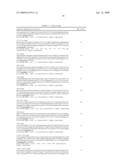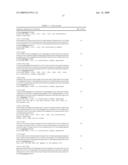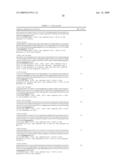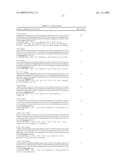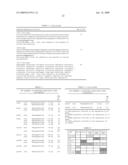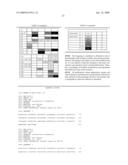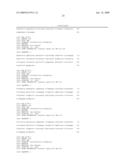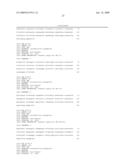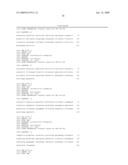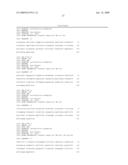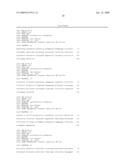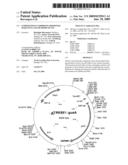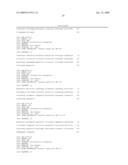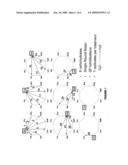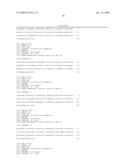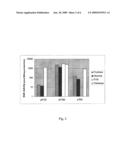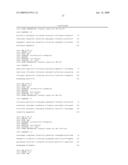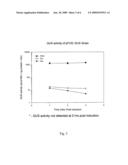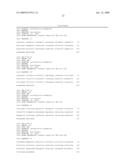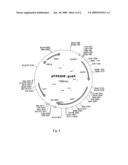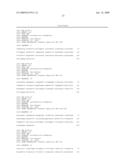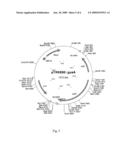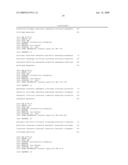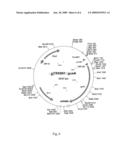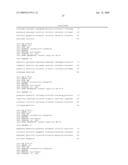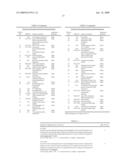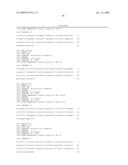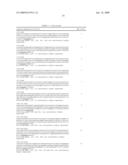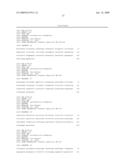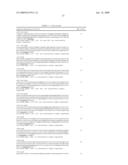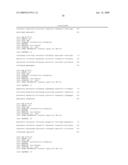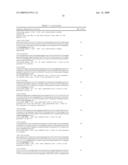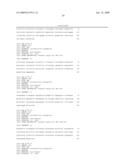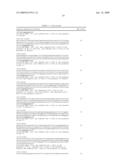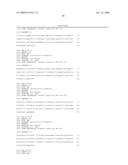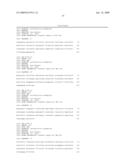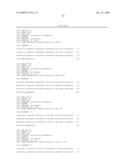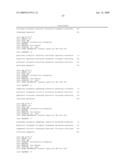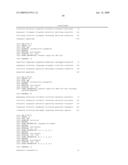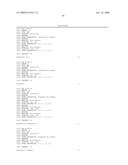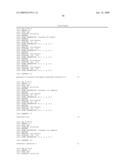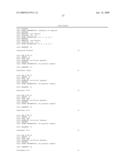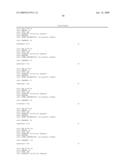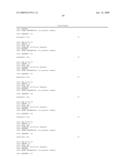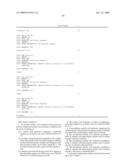Patent application title: COMPOSITIONS COMPRISING PROMOTER SEQUENCES AND METHODS OF USE
Inventors:
Rodolphe Barrangou (Madison, WI, US)
Andrea Azcarate-Peril (Raleigh, NC, US)
Eric Altermann (Palmerston North, NZ)
Tri Duong (Pullman, WA, US)
Todd R. Klaenhammer (Raleigh, NC, US)
Assignees:
NORTH CAROLINA STATE UNIVERSITY
IPC8 Class: AC12N1587FI
USPC Class:
435471
Class name: Chemistry: molecular biology and microbiology process of mutation, cell fusion, or genetic modification introduction of a polynucleotide molecule into or rearrangement of nucleic acid within a microorganism (e.g., bacteria, protozoa, bacteriophage, etc.)
Publication date: 2009-06-18
Patent application number: 20090155913
Claims:
1. An isolated nucleic acid molecule having promoter activity, wherein the
nucleic acid molecule is selected from the group consisting of:(a) a
nucleic acid molecule comprising a nucleotide sequence as set forth in
any one of SEQ ID NOS:65 or 73;(b) a nucleic acid molecule that
hybridizes to the complement of the nucleic acid of (a) under stringent
conditions and has promoter activity, wherein said stringent conditions
comprise 6.times.SSC, 0.1% SDS at about 45.degree. C., followed by a wash
of 0.2.times.SSC and 0.1% SDS at 50-65.degree. C.; and(c) a nucleic acid
molecule having at least 95% identity to the nucleotide sequence set
forth in any one of SEQ ID NOS:65 or 73 and has promoter activity.
2. The nucleic acid molecule of claim 1 comprising a nucleotide sequence as set forth in any one of SEQ ID NOS:65 or 73.
3. A recombinant nucleic acid molecule comprising the isolated nucleic acid molecule according to claim 1 operably associated with a heterologous nucleic acid of interest.
4. The recombinant nucleic acid molecule according to claim 3, wherein said heterologous nucleic acid of interest encodes a protein or peptide.
5. The recombinant nucleic acid molecule according to claim 3, wherein said heterologous nucleic acid of interest encodes an antisense oligonucleotide.
6. The recombinant nucleic acid molecule according to claim 3, wherein said heterologous nucleic acid of interest encodes a ribozyme or interfering RNA.
7. A plasmid comprising the nucleic acid molecule according to any of claim 1.
8. A method of transforming a cell comprising introducing the nucleic acid molecule according to claim 1 into a cell.
9. A cell comprising a heterologous nucleic acid molecule according to claim 1.
10. A cell comprising the plasmid according to claim 7.
11. The cell according to claim 9, wherein said cell is a lactic acid producing bacterial cell.
12. The cell according to claim 9, wherein said cell is selected from the group consisting of a cell of a gram positive bacterium, a lactic acid bacteria, Lactobacillus acidophilus, Lactococcus lactis or Lactobacillus gasserei.
13. A method of controlling the transcription of a nucleic acid of interest in a cell comprising:(a) providing or maintaining the cell under non-inducing conditions, said cell comprising the recombinant nucleic acid molecule of claim 3, and(b) subjecting said cell to inducing conditions whereby transcription of said nucleic acid of interest is increased as compared to the level of transcription of said nucleic acid of interest under non-inducing conditions.
14. The method according to claim 13, wherein said nucleic acid of interest encodes a protein or a peptide.
15. The method according to claim 13, wherein said nucleic acid of interest encodes an antisense oligonucleotide or a ribozyme.
16. The method according to claim 13, wherein said inducing conditions described in (b) are produced by an increase or decrease in the concentration of a sugar in said cell relative to the concentration of said sugar in said cell under non-inducing conditions.
17. The method according to claim 13, wherein said inducing conditions described in (b) are produced by the presence of a stress response protein.
18. A method to express a nucleotide sequence of interest in a cell comprising introducing into said cell the recombinant nucleic acid molecule of claim 3.
19. A method to express a nucleotide sequence of interest in a cell comprising introducing into said cell the nucleic aid molecule of claim 1, wherein said nucleic acid molecule is heterologous to said cell and is operably linked to said nucleotide sequence of interest.
20. An isolated nucleic acid molecule comprising a nucleotide sequence having at least 95% sequence identity to SEQ ID NO:6, wherein said nucleotide sequence has promoter activity.
21. A method to express a nucleotide sequence of interest in a cell comprising introducing into said cell a recombinant nucleic aid molecule comprising a polynucleotide having at least 95% sequence identity to SEQ ID NO:6 or comprising SEQ ID NO:6, wherein said polynucleotide has promoter activity and is operably linked to the nucleotide sequence of interest.
Description:
CROSS-REFERENCE TO RELATED APPLICATIONS
[0001]This application is a divisional of U.S. application Ser. No. 11/330,471, filed Jan. 12, 2006, which claims the benefit of U.S. Provisional Application No. 60/644,189, filed Jan. 14, 2005, which is herein incorporated by reference in its entirety.
INCORPORATION OF SEQUENCE LISTING
[0002]The application contains a sequence listing, a paper copy of which is filed concurrently herewith via EFS Web. The CRF copy of the sequence listing filed on Apr. 7, 2006 has been transferred from the parent application (U.S. application Ser. No. 11/330,471). The content of the attached paper copy of the listing and the CRF copy transferred from U.S. application Ser. No. 11/330,471 are the same. The sequence listing is hereby incorporated in its entirety into the instant specification.
FIELD OF THE INVENTION
[0003]The present invention is directed to promoters in general, as well as, nucleic acid constructs comprising such promoters operably associated with a nucleic acid of interest in a recombinant nucleic acid molecule, cells containing the same, and methods of making and using the same.
BACKGROUND OF THE INVENTION
[0004]The gastrointestinal tract is the most densely colonized region of the human body (Savage, Ann. Rev. Microbiol. 31, 107 (1977); Tannock, Normal microflora (Chapman and Hall, London 1995)) and the accumulated evidence indicates that this collection of microbes has a powerful influence on the host in which it resides. Comparisons between germ free and conventional animals have shown that many biochemical, physiological and immunological functions are influenced by the presence of the diverse and metabolically active bacterial community residing in the gastrointestinal tract (Marteau and Rambaud, FEMS Microbiol. Rev. 12, 207 (1993); Norin et al., Appl. Environ. Microbiol. 74, 1850 (1991); Tannock, supra). Lactobacilli are important residents of the microflora (Ahrne et al., J. Appl. Microbiol. 85, 88 (1998); Kimura et al., Appl. Environ. Microbiol. 63, 3394 (1997)), and have been the subject of intense and growing interest because of their possible role in the maintenance of gastrointestinal health (Bengmark, Gut 42, 2 (1998)). Of immense importance to lactobacilli functioning in this role is the ability to endure in the harsh conditions of the gastrointestinal tract, where the gastric pH frequently falls below 2.0 in healthy individuals (McLauchlan et al., Gut 30, 573 (1998)).
[0005]The identification of conditionally expressed genes provides a wealth of insight into the physiological consequences of and responses to a given stimulus. In the case of Lactobacillus acidophilus, a significant challenge has been in understanding the intestinal roles and activities of this organism. An important element in this regard is the determination of which characteristics are important for the survival and success of this organism in the gastrointestinal tract. While differential display (Liang and Pardee, Science 257, 967 (1992); Welsh et al., Nucleic Acids Res. 20, 4965 (1992)) has been used extensively to identify conditionally expressed genes in eukaryotes, the application of this methodology in prokaryotes has not been explored to a comparatively significant extent (Abu Kwaik and Pederson, Mol. Microbiol. 21, 543 (1996); Fislage, Electrophoresis 19, 613 (1998); Fislage et al., Nucleic Acids Res. 25, 1830 (1997); Wong and McClelland, Proc. Natl. Acad. Sci. USA 91, 639 (1994); Zhang and Normark, Science 273, 1234 (1996)). Some of the practical problems in employing these methods in prokaryotes include the relatively large proportion of structural RNA species in the total RNA, the low level of polyadenylation of mRNA (Sarkar, Ann. Rev. Biochem. 66, 173 (1997)), which prohibits the use of 3' dT anchored primers and the structural instability and short half life of low abundance mRNA species of prokaryotes as compared to eukaryotes (Higgins et al., Curr. Opin. Genet. Dev. 2:739 (1992)).
[0006]The present invention contributes to the art by providing promoters as compositions and for use in methods of expressing nucleic acids in a variety of conditions.
BRIEF DESCRIPTION OF THE DRAWINGS
[0007]FIG. 1 is a schematic of the experimental design of the microarray assays described herein.
[0008]FIG. 2 provides an overview of expression data from a GUS reporter gene assay. pFOS refers to the 502_sugar promoter sequence set forth in SEQ ID NO: 72; pTRE refers to the 1012_sugar promoter sequence set forth in SEQ ID NO:73; and, pPGM refers to the 185_high promoter set forth in SEQ ID NO:6.
[0009]FIG. 3 is a detailed representation (through time) of the pFOS (promoter 502_sugars) (SEQ ID NO:72) data. It shows that this promoter is inducible in the presence of FOS when compared to glucose and fructose.
[0010]FIG. 4 provides a non-limiting schematic of an expression vector for the pFOS promoter (SEQ ID NO:72).
[0011]FIG. 5 provides a non-limiting schematic of an expression vector for the pTRE promoter (SEQ ID NO:73).
[0012]FIG. 6 provides a non-limiting schematic of an expression vector for the pPGM promoter (SEQ ID NO:6).
SUMMARY OF THE INVENTION
[0013]Methods and compositions for regulating gene expression are provided.
[0014]Compositions comprise isolated nucleic acid molecules comprising (a) a nucleic acid comprising a nucleotide sequence as set forth in any one of SEQ ID NOS: 1-80 or a fragment thereof; (b) a nucleic acid that hybridizes to the complement of the nucleic acid of (a) under stringent conditions, wherein the sequence has promoter activity; and (c) a nucleic acid having at least 70%, 80%, 90%, 95% or greater sequence identity to the nucleotide sequence set forth in any one of SEQ ID NOS:1-80, wherein the sequence has promoter activity.
[0015]Further provided are recombinant nucleic acid molecules of SEQ ID NOS: 1-80 or biologically active variants or fragments thereof, wherein the molecules are operably linked to a heterologous nucleic acid of interest. Vectors having such recombinant nucleic acid molecules are also provided, as are cells having a heterologous nucleic acid molecule comprising the sequence of SEQ ID NOS:1-80 and biologically active variants thereof.
[0016]Further provided are methods for controlling the transcription of a nucleic acid of interest. One method comprises (a) providing or maintaining the cell under non-inducing conditions, wherein the cell comprises at least one of the recombinant nucleic acid molecules of any one of SEQ ID NOS:1-80 or a biologically active variant or fragment thereof or a vector having the same, and (b) subjecting the cell to inducing conditions whereby transcription of the nucleic acid of interest is increased as compared to the level of transcription of the nucleic acid of interest under non-inducing conditions. Inducing conditions can be produced by increasing or decreasing the pH of the cell relative to the pH of the cell under non-inducing conditions; by administering or delivering the cell to a body cavity of the subject, wherein the body cavity has an acidic pH environment; by the fermentative production of an acid by the cell in a cell culture; by an increase or decrease in temperature of the cell relative to the temperature of the cell under non-inducing conditions; by an increase or decrease in the concentration of a sugar in the cell relative to the concentration of the sugar in the cell under non-inducing conditions; or, by the presence of a stress response protein.
[0017]Further included is a method to express a nucleotide sequence of interest in a cell comprising introducing into the cell a heterologous nucleic acid molecule comprising any one of SEQ ID NOS:1-80 or a biologically active variant or fragment thereof, wherein the nucleic acid molecule is operably linked to a nucleotide sequence of interest.
[0018]The foregoing and other objects and aspects of the invention are described herein and the specification set forth below.
DETAILED DESCRIPTION OF THE INVENTION
[0019]The present inventions now will be described more fully hereinafter with reference to the accompanying drawings, in which some, but not all embodiments of the inventions are shown. Indeed, these inventions may be embodied in many different forms and should not be construed as limited to the embodiments set forth herein; rather, these embodiments are provided so that this disclosure will satisfy applicable legal requirements. Like numbers refer to like elements throughout.
[0020]Many modifications and other embodiments of the inventions set forth herein will come to mind to one skilled in the art to which these inventions pertain having the benefit of the teachings presented in the foregoing descriptions and the associated drawings. Therefore, it is to be understood that the inventions are not to be limited to the specific embodiments disclosed and that modifications and other embodiments are intended to be included within the scope of the appended claims. Although specific terms are employed herein, they are used in a generic and descriptive sense only and not for purposes of limitation.
[0021]The present invention provides isolated nucleic acid molecules comprising, consisting essentially of and/or consisting of the nucleotide sequences as set forth in SEQ ID NOS:1-80. Also provided are isolated nucleic acid molecules having promoter activity, wherein the nucleic acid molecule is selected from the group consisting of: (a) a nucleic acid molecule comprising, consisting essentially of, and/or consisting of a nucleotide sequence as set forth in SEQ ID NOS:1-80 or a fragment thereof; (b) a nucleic acid molecule that hybridizes to the complement of the nucleic acid molecule of (a) under stringent conditions and has promoter activity; and (c) a nucleic acid molecule having at least 70%, 80%, 90%, 95% or greater sequence identity to the nucleic acid molecule of (a) or (b) and has promoter activity. A nucleic acid molecule having a nucleotide sequence that is complementary to any one of the nucleic acid molecules described herein is also provided in this invention.
[0022]In other embodiments, the present invention provides isolated nucleic acid molecules comprising the nucleotide sequences as set forth in SEQ ID NOS: 6, 72, or 73. Also provided are isolated nucleic acid molecules having promoter activity, wherein the nucleic acid molecule is selected from the group consisting of: (a) a nucleic acid molecule comprising, consisting essentially of, and/or consisting of a nucleotide sequence as set forth in SEQ ID NOS: 6, 72, or 73 or a fragment thereof; (b) a nucleic acid molecule that hybridizes to the complement of the nucleic acid molecule of (a) under stringent conditions and has promoter activity; and (c) a nucleic acid molecule having at least 70%, 80%, 90%, 95% or greater sequence identity to the nucleic acid molecule of (a) or (b) and has promoter activity.
[0023]Variant nucleic acid molecules sufficiently identical to the nucleotide sequences set forth herein are also encompassed by the present invention. Additionally, fragments and sufficiently identical fragments of the nucleotide sequences are encompassed. Nucleotide sequences that are complementary to a nucleotide sequence of the invention, and/or that hybridize to a nucleotide sequence, or complement thereof, of the invention are also encompassed.
[0024]Compositions of this invention further include vectors and cells for recombinant expression of the nucleic acid molecules described herein, as well as transgenic microbial and/or cell populations comprising the nucleic acids and/or vectors. Also included in the invention are methods for the recombinant production of heterologous peptides and/or polypeptides and methods for their use.
[0025]Another aspect of the present invention is an isolated nucleic acid comprising: (a) a first nucleotide sequence having promoter activity, wherein the promoter can be a constitutively active promoter or an inducible promoter, wherein the latter can be induced by a variety of factors, including but not limited to, pH, growth temperature, oxygen content, a temperature shift, the composition of the growth medium (including the ionic strength/NaCl content), the presence or absence of essential cell constituents or precursors, the growth phase and/or the growth rate of a cell or cell population, and any of a variety of inducing compounds and/or chemicals that are well known in the art, as described herein; and (b) a second nucleotide sequence having a position, orientation, presence and/or sequence which imparts a regulatory effect on the expression of a nucleic acid sequence operably linked to the first nucleotide sequence having promoter activity. A nucleic acid molecule of this embodiment can be, for example, a nucleic acid having a nucleotide sequence as set forth in SEQ ID NOS:1-80 or SEQ ID NO: 6, 72, or 73 as provided herein, and/or a nucleic acid that hybridizes with the complement of a nucleic acid having the nucleotide sequence as set forth in SEQ ID NOS:1-80 or SEQ ID NO:6, 72, or 73 and has the promoter and regulatory activity described herein. The nucleic acid molecule of this embodiment can also be a nucleic acid molecule having at least 70% homology to a nucleic acid molecule having a nucleotide sequence of SEQ ID NOS:1-80 or SEQ ID NO: 6, 72, or 73 and having promoter and regulatory activity as described herein.
[0026]In one embodiment, the nucleic acid molecule according to the present invention may be induced by sugar (including, but not limited to, glucose, fructose, sucrose, trehalose, fructooligosaccharide, raffinose, lactose and/or galactose) and may be referred to herein as a "sugar-induced" promoter. Suitably at least SEQ ID NOS:70-80 may be sugar-induced promoters.
[0027]In another embodiment, the nucleic acid molecule according to the present invention may be induced by exposure to a stress response (including, but not limited to, change in pH, exposure to bile, oxalate and/or ethanol alone or in various combinations) or to a stress response protein and may be referred to herein as a "stress-induced" promoter. Suitably at least SEQ ID NOS:44-69 may be stress-induced promoters. In other embodiments, exposure to a stress response contributes to repression of a promoter.
[0028]In another embodiment, the nucleic acid molecule according to the present invention may be induced by growth temperature or a shift in temperature (and may be referred to herein as a "temperature-induced" promoter).
[0029]In another embodiment, the nucleic acid molecule according to the present invention may be induced by Fos (and may be referred to herein as a "Fos-induced" promoter). Suitably at least SEQ ID NO: 72.
[0030]The nucleic acid molecules comprising promoters of the present invention have applications in a number of scenarios. The promoters of this invention can be used for the expression of nucleic acid molecules to yield gene products, for example, during the normal course of fermentation by cells such as bacterial cells, particularly lactic acid bacteria, in dairy, meat, vegetable, cereal, and other bioconversions. The promoters of this invention can also be used for the production of gene products upon exposure of lactic acid bacteria to certain environmental stimuli (e.g., acid environments), including, for example, suspension into acidified foods or entry into the gastrointestinal tract or other body cavities as probiotic bacteria.
[0031]The nucleic acid molecules of this invention can be used in some embodiments for the expression of nucleic acid molecules encoding enzymes, antigens, proteins, peptides, etc., from lactic acid and/or other bacteria that can be used, for example, as delivery or production systems.
[0032]Accordingly, a further aspect of the invention is a recombinant nucleic acid comprising a promoter of this invention operably associated with a nucleic acid of interest. In some embodiments, the nucleic acid of interest can encode a protein or peptide, the production of which can be upregulated, e.g., upon induction of the promoter. In other embodiments, the nucleic acid of interest can encode an antisense oligonucleotide that can suppress or inhibit the production of a protein in a cell, e.g., upon induction of the promoter. In other embodiments, the nucleic acid of interest can encode a ribozyme, an interfering RNA (RNAi), etc., that would be useful, for example, in situations where regulation of gene expression and/or protein production is desired.
[0033]As noted above, in some embodiments, the nucleic acid of interest can encode an antisense RNA. In general, "antisense" refers to the use of small, synthetic oligonucleotides to inhibit protein production by inhibiting the function of the target mRNA containing the complementary sequence (Milligan et al. (1993) J. Med. Chem. 36(14):1923-1937). Protein production is inhibited through hybridization of the antisense sequence to coding (sense) sequences in a specific mRNA target by hydrogen bonding according to Watson-Crick base pairing rules. The mechanism of antisense inhibition is that the exogenously applied oligonucleotides decrease the mRNA and protein levels of the target gene (Milligan et al. (1993) J. Med. Chem. 36(14):1923-1937). See also Helene and Toulme (1990) Biochim. Biophys. Acta 1049:99-125; (Cohen, J. S., ed. (1987) Oligodeoxynucleotides as antisense inhibitors of gene expression (CRC Press:Boca Raton, Fla.)).
[0034]An additional aspect of the invention includes vectors and cells for recombinant expression of the nucleic acid molecules described herein, as well as transgenic cell populations comprising the vectors and/or nucleic acids of this invention. Also included in the invention are methods for the expression of nucleic acids of interest of this invention, resulting, for example, in the production of heterologous polypeptides and/or peptides, and methods for their use.
[0035]It is to be understood that in some embodiments of this invention, the nucleic acids of this invention encoding either a promoter or a nucleic acid of interest can be present in any number, in any order and in any combination, either on a single nucleic acid construct or on multiple nucleic acid constructs. For example, a promoter sequence and/or a nucleotide sequence of interest can be present as a single copy or as multiple copies on the same construct and/or on multiple constructs. Also, different promoter sequences and/or different nucleotide sequences of interest can be present on the same construct and/or on multiple constructs in any combination of multiple and/or single copies.
[0036]Further aspects of the invention include a method of transforming a cell with a nucleic acid and/or vector of this invention, comprising introducing the nucleic acid and/or vector of this invention into the cell according to methods well known in the art for transformation of cells with nucleic acid molecules. Where the nucleic acid of interest is to be transcribed within the cell, the cell can be one in which the promoter is operable (e.g., inducible by some stimulus such as acid pH or constitutively active). The nucleic acid of interest can be from a different organism than the transformed cell (e.g., a heterologous nucleic acid of interest), or the nucleic acid can be from the same organism as is the transformed cell, although in a recombinant nucleic acid molecule (in which case the nucleic acid of interest is heterologous in that it is not naturally occurring in the transformed cell).
[0037]A still further aspect of the invention is a method of controlling the transcription of a nucleic acid of interest, comprising: (a) providing a cell under non-inducing conditions, wherein the cell comprises a recombinant nucleic acid molecule that comprises an inducible promoter of this invention operably associated with a nucleic acid of interest; and (b) exposing, subjecting or introducing the cell to inducing conditions, e.g., an inducing environment whereby the promoter is induced to activate transcription of the nucleic acid of interest. The inducing environment can be an environment having a specific pH (e.g., an acidic pH) due to an increase or decrease in the pH as compared to non-inducing conditions, or having a specific temperature due to an increase or decrease of temperature as compared to non-inducing conditions, or containing an inducing element (e.g., a molecule or compound) that acts to induce the promoter to activate or increase transcription, resulting in a level of transcription that is greater than the level of transcription when the inducing environment or inducing element is not present, i.e., under non-inducing conditions. Thus, a non-inducing condition is meant to include conditions wherein the inducible promoter is not active or is not fully active in directing transcription.
[0038]Examples of inducing elements include, but are not limited to, organic acids (lactate, acetate, oxalate), pH, sodium chloride, oxygen, hydrogen peroxide, bile, ethanol, and carbohydrates (monosaccharides, disaccharides, oligosaccharides, and galactosides such as glucose, fructose, sucrose, trehalose, fructooligosaccharide, raffinose, lactose, and galactose).
[0039]In embodiments wherein the promoter is induced by exposure to an acidic pH, the inducing step can be carried out by any suitable means, including but not limited to, adding an exogenous acid to a cell in a culture, administering or delivering a cell to an acidic body cavity of a subject, producing an acid by fermentation in a cell culture, etc.
[0040]The nucleic acid of interest can encode various products, including but not limited to, a protein and/or peptide (e.g., an enzyme, a hormone, a growth factor, a cytokine, an antigen, a pro-drug, etc.) which can be both transcribed and translated in the cell), an antisense oligonucleotide, a ribozyme and/or an interfering RNA, etc. Suitable nucleic acids of interest can be of prokaryotic or eukaryotic origin.
[0041]As used herein, "a," "an" or "the" can be singular or plural. For example, "a cell" can mean a single cell or a multiplicity of cells.
[0042]The present invention provides promoters. Thus, in some embodiments of the invention, a nucleic acid molecule having promoter activity is provided comprising, consisting essentially of and/or consisting of a nucleotide sequence as set forth in SEQ ID NOS:1-80 or SEQ ID NO: 6, 72, or 73 or fragments (e.g., active fragments) or active variants thereof. Also provided is a nucleic acid molecule comprising, consisting essentially of and/or consisting of a nucleic acid having promoter activity operatively associated with a nucleic acid having activity as a regulatory element as described herein, which regulates the ability of the promoter sequence to activate transcription.
[0043]The nucleic acids of this invention are isolated and/or substantially purified. By "isolated" or "substantially purified" is meant that the nucleic acid, and/or fragments or variants, are substantially or essentially free from components normally found in association with nucleic acid in its natural state. Such components can include cellular material, culture medium from recombinant production, and/or various chemicals and reagents used in chemically synthesizing nucleic acids. An "isolated" nucleic acid of the present invention is free of nucleotide sequences that flank the nucleic acid of interest in the genomic DNA of the organism from which the nucleic acid was derived (such as coding sequences present at the 5' or 3' ends). However, the nucleic acid molecule of this invention can, in some embodiments, include additional bases and/or moieties that do not deleteriously affect the basic characteristics and/or activities of the nucleic acid. Identification of such additional bases and/or moieties that do not have such a deleterious effect can be carried out by methods well known in the art.
[0044]In certain embodiments, the nucleic acid molecules of the present invention can be used to modulate the function of molecules. By "modulate," "alter," or "modify" is meant the up- or down-regulation of a target activity. Up- or down-regulation of expression of a nucleic acid of the present invention is encompassed. Up-regulation can be accomplished, for example, by 1) providing multiple copies of the nucleic acids of this invention, 2) modulating expression by modifying regulatory elements, 3) promoting transcriptional or translational mechanisms and 4) any other means known to upregulate expression of nucleic acid. Down-regulation can be accomplished, for example, by using well-known antisense and gene silencing techniques. "modify" is intended the up- or down-regulation of a target biological activity.
[0045]By "lactic acid bacteria" is meant bacteria from a genus selected from the following: Aerococcus, Carnobacterium, Enterococcus, Lactococcus, Lactobacillus, Leuconostoc, Oenococcus, Pediococcus, Streptococcus, Melissococcus, Alloiococcus, Dolosigranulum, Lactosphaera, Tetragenococcus, Vagococcus, and Weissella (Holzapfel et al. (2001) Am. J. Clin. Nutr. 73:365 S-373S; Williams and Wilkins (1986) Bergey's Manual of Systematic Bacteriology 2: 1075-1079 Baltimore).
[0046]By "Lactobacillus" is meant any bacteria from the genus Lactobacillus, including but not limited to L. casei, L. paracasei, L. rhamnosus, L. johnsonni, L. gasserei, L. acidophilus, L. crispatus, L. galinarum, L. plantarum, L. fermentum, L. salivarius, L. helveticus, L. bulgaricus, and numerous other species outlined by Wood et al. (Holzapfel, W. H. N. The Genera of Lactic Acid Bacteria, Vol. 2. 1995. Brian J. B. Wood, Ed. Aspen Publishers, Inc.)
[0047]The nucleic acid molecules of the present invention are also useful in modifying milk-derived products. These uses include, but are not limited to, modulating the growth rate of a bacterium, modifying the flavor of a fermented dairy product, modulating the acidification rate of a milk product fermented by lactic acid bacteria, and altering products produced during fermentation.
[0048]In addition to the isolated nucleic acid molecules comprising nucleotide sequences as set forth in SEQ ID NOS:1-80 or SEQ ID NOS: 6, 72, or 73, the present invention also provides fragments and variants of these nucleotide sequences. By "fragment" of a nucleotide sequence is meant a nucleic acid molecule that is made up of a nucleotide sequence that is the same as a portion of a nucleotide sequence of SEQ ID NOS:1-80, but has fewer nucleotides than the entire nucleotide sequence as set forth in SEQ ID NOS:1-80, as well as, a nucleic acid molecule that is made up of a nucleotide sequence that has fewer nucleotides than the entire nucleotide sequence of a nucleic acid that has substantial homology to a nucleotide sequence of SEQ ID NOS:1-80 as described herein and also including a nucleic acid molecule that is made up of nucleotide sequence that has fewer nucleotides than the entire nucleotide sequence of a nucleic acid that hybridizes to a nucleotide sequence of SEQ ID NOS:1-80 or the complement thereof, under the conditions described herein.
[0049]In one embodiment of the invention, fragments of the polynucleotides of SEQ ID NOS:1-80 are provided. A biologically active fragment of a polynucleotide of SEQ ID NOS:1-80 can comprise, for example, 5, 10, 15, 20, 25, 30, 40, 50, 75, 100, 150, 200, 300, 400, or 500 contiguous nucleotides in length, including any number between 5 and 500 not specifically recited herein, or up to the total number of nucleotides present in a full-length polynucleotide of the invention. Such biologically active fragments can continue to be biologically active (i.e., have promoter activity).
[0050]In another embodiment of the invention, fragments of the polynucleotides of SEQ ID NOS: 6, 72 or 73 are provided. A biologically active fragment of a polynucleotide of SEQ ID NOS:6, 72, or 73 can comprise, for example, 5, 10, 15, 20, 25, 30, 40, 50, 75, 100, 150, 200, 300, 400, or 500 contiguous nucleotides in length, including any number between 5 and 500 not specifically recited herein, or up to the total number of nucleotides present in a full-length polynucleotide of the invention. Such biologically active fragments can continue to be biologically active (i.e., have promoter activity).
[0051]An "active fragment" of this invention is a fragment of a nucleotide sequence of this invention that has activity, such as promoter activity and/or promoter-regulating activity as determined by any well-known protocol for detecting and/or measuring promoter activity and/or promoter-regulating activity. An active fragment can also include a fragment that is functional as a probe and/or primer. For example, fragments of the nucleic acids disclosed herein can be used as hybridization probes to identify nucleic acids in a sample having varying degrees of homology to the nucleic acid molecules of this invention, and/or can be used as primers in amplification protocols (e.g., polymerase chain reaction (PCR) or other well-known amplification methods) and/or to introduce mutations into a nucleotide sequence. In some embodiments, fragments of this invention can be bound to a physical substrate to comprise a macro- or microarray (see, for example, U.S. Pat. No. 5,837,832; U.S. Pat. No. 5,861,242; U.S. Pat. No. 6,309,823, and International Publication Nos. WO 89/10977, WO 89/11548, and WO 93/17126). Such arrays of nucleic acids can be used to study gene expression and/r to identify nucleic acid molecules with sufficient identity to the target sequences.
[0052]A "variant" of a nucleic acid of this invention includes a nucleotide sequence that is substantially homologous to, but not identical to, a nucleic acid of this invention and that retains activity as described herein. By "substantially homologous" is meant that the variant nucleic acid has at least 50, 60, 70, 80, 85, 90, 91, 92, 93, 94, 95, 96, 97, 98 or 99% sequence identity with a nucleic acid of this invention, as further described herein.
[0053]In one embodiment of the invention, variants of polynucleotides of SEQ ID NOS: 1-80 are provided. A variant of a polynucleotide of SEQ ID NOS: 1-80 can comprise, in general, nucleotide sequences that have at least about 45%, 55%, 65%, 70%, 75%, 80%, 85% or 90%, 91%, 92%, 93%, 94%, 95%, 95%, 96%, 97%, 98%, or 99% sequence identity to SEQ ID NOS:1-80. Biologically active variants can continue to be biologically active (i.e., have promoter activity).
[0054]In another embodiment of the invention, variants of polynucleotides of SEQ ID NOS:6, 72 or 73 are provided. A variant of a polynucleotide of SEQ ID NOS:6, 72, or 73 can comprise, in general, nucleotide sequences that have at least about 45%, 55%, 65%, 70%, 75%, 80%, 85% or 90%, 91%, 92%, 93%, 94%, 95%, 95%, 96%, 97%, 98%, or 99% sequence identity to SEQ ID NOS:6, 72, or 73. Biologically active variants can continue to be biologically active (i.e., have promoter activity).
[0055]The present invention further encompasses homologous nucleic acid sequences identified and/or isolated from other organisms or cells by hybridization with entire or partial nucleic acid sequences of the present invention, as well as, variants and/or fragments thereof. Such hybridization protocols are standard in the art and some examples are provided herein.
[0056]An active nucleotide fragment of this invention can be prepared by various methods known in the art, such as by 1) chemical synthesis, 2) restriction digestion, 3) selective amplification and 4) selective isolation of a desired fragment. The activity of the fragment can be determined by well-known methods as described herein. In some embodiments, a fragment of a nucleic acid of this invention can comprise at least about 5, 10, 15, 20, 25, 30, 35, 40, 45, 50, 75, 100, 125, 150, 175, or 200 contiguous nucleotides, including any number between 5 and 200 not specifically recited herein, or up to the total number of nucleotides present in a full-length nucleotide sequence of this invention. The term "about", as used herein when referring to a measurable value such as a number of nucleotides, is meant to encompass variations of ±20%, ±10%, ±5%, ±1%, ±0.5%, or even ±0.1% of the specified amount.
[0057]The present invention further provides nucleic acids comprising promoters and promoter elements that direct expression of the nucleic acids of this invention according to the methods described herein. Bacterial promoters are identified as comprising various elements that facilitate ribosome binding on the messenger RNA in the region upstream of the first initiation codon of an open reading frame. These elements can include a hexamer region centered around nucleotide -10 and/or another hexamer centered around nucleotide -35, counting upstream from the first nucleotide of the initiation codon in negative numbers. An example of a -10 hexamer is TATAAT (SEQ ID NO: 109) and an example of a -35 hexamer is TTGACA ((SEQ ID NO: 110) e.g., as part of TCTTGACAT) (SEQ ID NO: 111). These hexamers are recognized by the σ subunit of the RNA polymerase. There is also a spacer region connecting these two hexamers, the length of which is commonly conserved in most bacteria to be 17±5 base pairs. A TG motif upstream of the -10 hexamer is also commonly found in bacterial promoters, as well as an UP element, which is an AT-rich sequence upstream of the -35 hexamer (e.g., commonly around -40 to -60). This latter element is contacted by the C-terminal domain of the RNA polymerase α-subunit. Nonlimiting examples of a consensus sequence for an UP element of a bacterial promoter of this invention include
TABLE-US-00001 (SEQ ID NO:81) nnAAA(A/T)(A/T)T(A/T)TTTTnnAAAAnnn, (SEQ ID NO:82) NNAWWWWWTTTTTN, (SEQ ID NO:83) AAAAAARNR, (SEQ ID NO:84) NNAAAWWTWTTTTNNNAAANNN, (SEQ ID NO:85) AAAWWWTWTTTTNNNAAA and (SEQ ID NO:86) GNAAAAATWTNTTNAAAAAAMNCTTGMA(N)18TATAAT,
where W is A or T; M is A or C; R is A or G; and N is any base. Also included are complements of these sequences.
[0058]Thus, in certain embodiments, the present invention provides an isolated nucleic acid comprising from about 50 or 75 to about 100, 125, 150, 175, or 200 contiguous nucleotides, including any number between 50 and 200 not specifically recited herein (e.g., 60, 75, 96, 179, etc.), said nucleotides being located immediately upstream of the initiation codon of an open reading frame of this invention or upstream of a sequence corresponding to tRNA or rRNA, and numbered from between -1 to -200 in the nucleotide sequence, starting with the first nucleotide of the initiation codon or tRNA or rRNA sequence and numbering backwards in negative numbers, and further wherein said sequence of contiguous nucleotides comprises one or more of the promoter elements described herein and/or one or more nucleotide sequences having substantial similarity to a promoter element described herein and wherein said nucleic acid has promoter activity and/or potential promoter activity as detected according to methods standard in the art. (See, e.g., McCracken et al. (2000) "Analysis of promoter sequences from Lactobacillus and Lactococcus and their activity in several Lactobacillus species" Arch. Microbiol. 173:383-389; Estrem et al. (1998) "Identification of an UP element consensus sequence for bacterial promoters" Proc. Natl. Acad. Sci. USA 95:9761-9766; Ross et al. (1998) "Escherichia coli promoters with UP elements of different strengths: Modular structure of bacterial promoters" J. Bacteriol. 180:5375-5383; U.S. Pat. No. 6,605,431 to Gourse et al., entitled "Promoter elements and methods of use"; and PCT publication number WO 2004/067772, published Aug. 12, 2004 and entitled "Method for the identification and isolation of strong bacterial promoters.") Each of these references is incorporated herein in its entirety for teachings regarding bacterial promoters and bacterial promoter elements and for additional examples of nucleotide sequences of bacterial promoter elements described herein.
[0059]The nucleic acid molecules of this invention comprising promoters and/or promoter elements have practical utility in the regulation of expression of homologous and/or heterologous nucleic acids, for example, to produce proteins for use in the various embodiments of this invention, as well as in any commercial application, such as, e.g., bacterial fermentation processes (e.g., production of insulin, blood coagulation proteins, etc.)
[0060]In some embodiments, the nucleic acid molecules of this invention comprise a regulatory element that modulates the ability of the promoter to activate transcription. Regulatory elements of the present invention are generally located within the approximately 0.2 kb of DNA 5' to the open reading frames of the Lactobacillus acidophilus NCFM genome. It will be apparent that other sequence fragments, longer or shorter than the foregoing sequence, or with minor additions, deletions, or substitutions made thereto, as those that result, for example from site-directed mutagenesis, as well as from synthetically derived sequences, are included within the present invention.
[0061]In one embodiment of the invention, a nucleic acid molecule of this invention comprises a regulatory element that is a catabolite response element (cre). By "catabolite response element," "cre sequence" or "cre-like sequence" is meant a cis-acting DNA sequence involved in catabolite repression. Expression of many catabolic enzymes in gram-positive bacteria is subject to repression by glucose and other rapidly metabolizable sources of carbon (Stewart (1993) J. Cell. Biochem. 51:25-28; Hueck and Hillen (1995) Mol. Microbiol. 143:147-148). This catabolite repression of such genes in gram-positive bacteria, notably Bacillus subtilis, is under the control of cis-acting nucleotide sequences described as cre sequences. These sequences contain a 2-fold axis of symmetry, are generally located in the region of promoter elements, can be present in multiples (e.g., pairs), and can vary in sequence location relative to the transcription start site for the transcription product under control of a given promoter element. Consensus nucleotide sequences for cre sequences are known in the art. Nonlimiting examples of consensus cre sequences include TGWAANCGNTNWCA (SEQ ID NO:87) (Weickert and Chambliss. 1990 Proc. Natl. Acad. Sci. USA 87:6238-6242); WWWWTGWAARCGYTWNCWWWW (SEQ ID NO:88)(Zallieckas et al. (1998) J. Bacteriol. 180:6649-6654); and WWTGNAARCGNWWWCAWW (SEQ ID NO:89) (Miwa et al. (2000) Nucleic Acids Res. 28:1206-1210). Thus, in some embodiments, the present invention provides promoter sequences comprising one or more cre sequences. In certain embodiments, a promoter sequence of this invention can comprises one, two, or more than two cre sequences. Furthermore, the present invention provides fragments of the promoters of this invention, wherein the fragment comprises and/or consists essentially of a consensus cre sequence and/or a sequence that can be up to 70%, 75%, 80%, 85%, 90%, 95%, or 99% homologous to a consensus cre sequence.
[0062]The regulatory elements of this invention that enhance activation of transcription can increase nucleic acid transcription by at least 50%, 60%, 70%, 80%, 90%, 100%, 150%, 200%, 300% or more. The regulatory elements of this invention that suppress transcription can do so by at least 25%, 35%, 50%, 60%, 75%, 85%, 95% or more, up to and including 100%.
[0063]In other embodiments, the sequence of the nucleic acid encoding the regulatory element can correspond to a portion of the nucleotide sequence of a nucleic acid of this invention, such as the nucleotide sequences as set forth in SEQ ID NOS:1-80 or SEQ ID NO: 6, 72, or 73. Also included herein are fragments of a nucleotide sequence that is a regulatory element, wherein the fragment retains activity of the regulatory element. Nucleic acids of this invention that are fragments of a promoter or regulatory element can comprise, consist essentially of and/or consist of at least 15, 20, 25, 30, 35, 40, 45, 50, 75, 100, 125, 150, 175, or 200 contiguous nucleotides of the full-length sequence. Particular fragment lengths will depend upon the objective and will also vary depending upon the particular promoter or regulatory sequence.
[0064]The nucleotides of such fragments will usually comprise the TATA recognition sequence of the particular promoter sequence. Such fragments can be obtained by use of restriction enzymes to cleave the naturally occurring promoter nucleotide sequence disclosed herein; by synthesizing a nucleotide sequence from the naturally occurring sequence of the promoter nucleic acid sequence; or through the use of amplification protocols, such as PCR. See, for example, Mullis et al. (1987) Methods Enzymol. 155:335-350, and Erlich, ed. (1989) PCR Technology (Stockton Press, New York). Variants of these promoter fragments, such as those resulting from site-directed mutagenesis, are also encompassed in the present invention, as such variants are described herein.
[0065]Regulatory elements of the present invention can also include nucleic acids that regulate expression of nucleic acids and have a sequence that is substantially homologous to a nucleotide sequence comprising a regulatory element as disclosed herein, and particularly a nucleotide sequence comprising a regulatory element as disclosed herein as SEQ ID NOS:1-80.
[0066]Thus, a nucleic acid encoding a regulatory element of this invention includes a nucleic acid that is at least about 75%, 80%, 85%, 90%, 91%, 92%, 93%, 94%, 95%, 96%, 97%, 98% or 99% homologous to a nucleic acid encoding a regulatory element as described herein, and in particular a nucleic acid encoding a regulatory element and having the nucleotide sequence set forth herein as SEQ ID NOS:1-80 or SEQ ID NOS: 6, 72, or 73. Regulatory elements from other species are also encompassed herein and include those that are at least about 75%, 80%, 85%, 90% or 95% homologous to a continuous segment of a regulatory element of the present invention, and which are capable of regulating the activation of transcription of nucleic acids.
[0067]As used herein, two nucleotide sequences are "substantially homologous" when they have at least about 50%, 60%, 70%, 80%, 85%, 90%, 91%, 92%, 93%, 94%, 95%, 96%, 97%, 98% or 99% homology with one another.
[0068]The term "homology" as used herein refers to a degree of similarity between two or more sequences. There can be partial homology or complete homology (i.e., identity). A partially homologous nucleic acid sequence that at least partially inhibits a complementary nucleic acid sequence from hybridizing to a target nucleic acid is referred to using the functional term "substantially homologous." The inhibition of hybridization to the target sequence can be examined using a hybridization assay (Southern or Northern blot, solution hybridization and the like) under conditions of varying stringency, as that term is known in the art. A substantially homologous sequence or hybridization probe will compete for and inhibit the binding of a completely complementary sequence to the target sequence under conditions of low stringency. This is not to say that conditions of low stringency are such that non-specific binding is permitted; low stringency conditions require that the binding of two sequences to one another be a specific (i.e., selective) interaction. The absence of non-specific binding can be tested by the use of a second target sequence, which lacks even a partial degree of complementarity (e.g., less than about 30%). In the absence of non-specific binding, the probe will not hybridize to the second non-complementary target sequence.
[0069]Alternatively stated, in particular embodiments, nucleic acids that hybridize under the conditions described herein to the complement of the sequences specifically disclosed herein can also be used according to the present invention. The term "hybridization" as used herein refers to any process by which a first strand of nucleic acid binds with a second strand of nucleic acid through base pairing.
[0070]The term "stringent" as used here refers to hybridization conditions that are commonly understood in the art to define the conditions of the hybridization procedure. Stringency conditions can be low, high or medium, as those terms are commonly know in the art and well recognized by one of ordinary skill. High stringency hybridization conditions that will permit a complementary nucleotide sequence to hybridize to a nucleotide sequence as given herein are well known in the art. As one example, hybridization of such sequences to the nucleic acid molecules disclosed herein can be carried out in 25% formamide, 5×SSC, 5×Denhardt's solution and 5% dextran sulfate at 42° C., with wash conditions of 25% formamide, 5×SSC and 0.1% SDS at 42° C., to allow hybridization of sequences of about 60% homology. Another example includes hybridization conditions of 6×SSC, 0.1% SDS at about 45° C., followed by wash conditions of 0.2×SSC, 0.1% SDS at 50-65° C. Another example of stringent conditions is represented by a wash stringency of 0.3M NaCl, 0.03M sodium citrate and 0.1% SDS at 60-70° C. using a standard hybridization assay (see Sambrook et al., eds., Molecular Cloning: A Laboratory Manual 2d ed. (Cold Spring Harbor, N.Y. 1989, the entire contents of which are incorporated by reference herein). In various embodiments, stringent conditions can include, for example, highly stringent (i.e., high stringency) conditions (e.g., hybridization to filter-bound DNA in 0.5 M NaHPO4, 7% sodium dodecyl sulfate (SDS) and 1 mM EDTA at 65° C., and washing in 0.1×SSC/0.1% SDS at 68° C.), and/or moderately stringent (i.e., medium stringency) conditions (e.g., washing in 0.2×SSC/0.1% SDS at 42° C.).
[0071]As is known in the art, a number of different programs can be used to identify whether a nucleic acid or amino acid has homology (e.g., sequence identity or similarity) to a known sequence. Homology can be determined using standard techniques known in the art, including, but not limited to, the local sequence identity algorithm of Smith and Waterman (1981) Adv. Appl. Math. 2:482, the sequence identity alignment algorithm of Needleman and Wunsch (1970) J. Mol. Biol. 48:443, the search for similarity method of Pearson and Lipman (1988) Proc. Natl. Acad. Sci. USA 85:2444, computerized implementations of these algorithms (GAP, BESTFIT, FASTA, and TFASTA in the Wisconsin Genetics Software Package, Genetics Computer Group, 575 Science Drive, Madison, Wis.) and/or the Best Fit sequence program described by Devereux et al. (1984) Nucl. Acid Res. 12:387-395, preferably using the default settings, or by inspection.
[0072]An example of a useful algorithm is PILEUP, which creates a multiple sequence alignment from a group of related sequences using progressive, pairwise alignments. It can also plot a tree showing the clustering relationships used to create the alignment. PILEUP uses a simplification of the progressive alignment method of Feng and Doolittle (1987) J. Mol. Evol. 35:351-360; which is similar to that described by Higgins and Sharp (1989) CABIOS 5:151-153.
[0073]Another example of a useful algorithm is the BLAST algorithm, described in Altschul et al., J. Mol. Biol. 215, 403-410, (1990) and Karlin et al., Proc. Natl. Acad. Sci. USA 90, 5873-5787 (1993). A particularly useful BLAST program is the WU-BLAST-2 program that was obtained from Altschul et al., Methods in Enzymology, 266, 460-480 (1996). WU-BLAST-2 uses several search parameters, which are preferably set to the default values. The parameters are dynamic values and are established by the program itself depending upon the composition of the particular sequence and composition of the particular database against which the sequence of interest is being searched; however, the values may be adjusted to increase sensitivity. An additional useful algorithm is gapped BLAST as reported by Altschul et al. Nucleic Acids Res. 25, 3389-3402.
[0074]The CLUSTAL program can also be used to determine sequence similarity. This algorithm is described by Higgins et al. (1988) Gene 73:237; Higgins et al. (1989) CABIOS 5:151-153; Corpet et al. (1988) Nucleic Acids Res. 16: 10881-90; Huang et al. (1992) CABIOS 8: 155-65; and Pearson et al. (1994) Meth. Mol. Biol. 24: 307-331.
[0075]Unless otherwise stated, sequence identity/similarity values provided herein refer to the value obtained using GAP Version 10 using the following parameters: % identity and % similarity for a nucleotide sequence using GAP Weight of 50 and Length Weight of 3, and the nwsgapdna.cmp scoring matrix or any equivalent program thereof. Other equivalent programs can also be used. By "equivalent program" is meant any sequence comparison program that, for any two sequences in question, generates an alignment having identical nucleotide or amino acid residue matches and an identical percent sequence identity when compared to the corresponding alignment generated by GAP Version 10.
[0076]In addition, for sequences that contain either more or fewer nucleotides than the nucleic acids disclosed herein, it is understood that in one embodiment, the percentage of sequence homology will be determined based on the number of identical nucleotides in relation to the total number of nucleotide bases. Thus, for example, sequence homology of sequences shorter than a sequence specifically disclosed herein can be determined using the number of nucleotide bases in the shorter sequence, in one embodiment. In percent homology calculations, relative weight is not assigned to various manifestations of sequence variation, such as, insertions, deletions, substitutions, etc.
[0077]The present invention also provides a recombinant nucleic acid comprising a nucleic acid encoding a regulatory element operably associated with a nucleic acid of interest. The nucleic acid encoding the regulatory element is operably associated with the nucleic acid of interest such that the regulatory element can modulate transcription of the nucleic acid of interest as directed by a nucleic acid having promoter activity. Typically, the nucleic acid encoding the regulatory element and/or the nucleic acid having promoter activity will be located 5' to the nucleic acid of interest, but either or both can also be located 3' to the nucleic acid of interest as long as they are operably associated therewith. There are no particular upper or lower limits as to the distance between the nucleic acid encoding the regulatory element and/or the nucleic acid having promoter activity and the nucleic acid of interest, as long as the nucleic acids are operably associated with one another.
[0078]The nucleic acid molecules of the present invention can also be included in vectors, which in some embodiments can be expression vectors. A vector of this invention can include one or more regulatory sequences to direct the expression of nucleic acids to which they are operably linked or operatively associated. The term "regulatory sequence" is meant to include, but is not limited to, promoters, operators, enhancers, transcriptional terminators, and/or other expression control elements such as translational control sequences (e.g., Shine-Dalgarno consensus sequence, initiation and termination codons). These regulatory sequences will differ, for example, depending on the cell into which the vector is to be introduced.
[0079]The vectors of this invention can be autonomously replicated in a cell (episomal vectors), or they can be integrated into the genome of a cell, and replicated along with the cell's genome (non-episomal vectors). Integrating vectors in prokaryotes typically contain at least one sequence homologous to the bacterial chromosome that allows for recombination to occur between homologous nucleic acid in the vector and the bacterial chromosome. Integrating vectors can also comprise bacteriophage or transposon sequences. Episomal vectors, or plasmids are typically circular double-stranded nucleic acid loops into which additional nucleic acid sequences can be ligated.
[0080]The vectors of this invention can comprise a nucleic acid of this invention in a form suitable for expression of the nucleic acid in a cell, which can be a eukaryotic or prokaryotic cell. It will be appreciated by those skilled in the art that the design of the vector can depend on such factors as the choice of the cell to be transformed, the level of expression of nucleic acid and/or production of protein desired, etc.
[0081]A promoter of this invention can be regulated in its transcription activity in various ways, as are known to one of ordinary skill in the art. For example, regulation can be achieved in some embodiments when a gene activator protein sequence is present. When present, such a sequence is usually proximal (5') to the RNA polymerase binding sequence.
[0082]An example of a gene activator protein is the catabolite activator protein (CAP), which helps initiate transcription of the lac operon in Escherichia coli (Raibaud et al. (1984) Annu. Rev. Genet. 18:173). Regulated expression can therefore be either positive or negative, thereby either enhancing or reducing transcription. Other examples of positive and negative regulatory elements are well known in the art. Various other promoters besides the promoters of this invention can be included in the vectors of this invention. Examples of such other promoters include, but are not limited to, a T7/LacO hybrid promoter, a trp promoter, a T7 promoter, a lac promoter, and a bacteriophage lambda promoter. Such other promoters can be constitutively active or inducible.
[0083]It is also contemplated that the promoters of the present invention can be combined with synthetic promoters that do not occur in nature, and/or such synthetic promoters can be present in a vector of this invention, in combination with a promoter of this invention. For example, transcription activation sequences of one bacterial or bacteriophage promoter may be joined with the operon sequences of another bacterial or bacteriophage promoter, creating a synthetic hybrid promoter (U.S. Pat. No. 4,551,433). For example, the tac (Amann et al. (1983) Gene 25:167; de Boer et al. (1983) Proc. Natl. Acad. Sci. 80:21) and trc (Brosius et al. (1985) J. Biol. Chem. 260:3539-3541) promoters are hybrid trp-lac promoters comprised of both trp promoter and lac operon sequences that are regulated by the lac repressor. The tac promoter has the additional feature of being an inducible regulatory sequence. Thus, for example, expression of a coding sequence operably linked to the tac promoter can be induced in a cell culture by adding isopropyl-1-thio-β-D-galactoside (IPTG).
[0084]Furthermore, a vector of this invention can include naturally occurring promoters of non-bacterial origin that have the ability to bind bacterial RNA polymerase and initiate transcription. A naturally occurring promoter of non-bacterial origin can also be coupled with a compatible RNA polymerase to produce high levels of expression of some nucleic acids in prokaryotes. The bacteriophage T7 RNA polymerase/promoter system is an example of a coupled promoter system (Studier et al. (1986) J. Mol. Biol. 189:113; Tabor et al. (1985) Proc. Natl. Acad. Sci. 82:1074). In addition, a hybrid promoter is also provided, which can comprise a bacteriophage promoter and a promoter or active region of a promoter of the present invention.
[0085]The vector of this invention can additionally comprise a nucleic acid sequence encoding a repressor (or inducer) for the promoter provided in the vector. For example, an inducible vector of the present invention may regulate transcription from the Lac operator (LacO) by expressing the gene encoding the LacI repressor protein. Other examples include the use of the lexA gene to regulate expression of pRecA, and the use of trpO to regulate ptrp. Alleles of such genes that increase the extent of repression (e.g., lacIq) or that modify the manner of induction (e.g., λCI857, rendering λpL thermo-inducible, or λCI+, rendering λpL chemo-inducible) may be employed.
[0086]In addition to a functioning promoter sequence, an efficient ribosome-binding site is also useful for the expression of nucleic acid sequences from the vectors of this invention. In prokaryotes, the ribosome binding site is called the Shine-Dalgarno (SD) sequence and includes an initiation codon (ATG) and a sequence 3-9 nucleotides in length located 3-11 nucleotides upstream of the initiation codon (Shine et al. (1975) Nature 254:34). The SD sequence is thought to promote binding of mRNA to the ribosome by the pairing of bases between the SD sequence and the 3' end of bacterial 16S rRNA (Steitz et al. (1979) "Genetic Signals and Nucleotide Sequences in Messenger RNA," in Biological Regulation and Development: Gene Expression (ed. R. F. Goldberger, Plenum Press, NY).
[0087]The nucleic acid of interest provided in this invention can encode a peptide and/or polypeptides that can be secreted from the cell. Such a peptide or polypeptide is produced by creating chimeric nucleic acid molecules that encode a protein or peptide comprising a signal peptide sequence that provides for secretion of polypeptides in bacteria (U.S. Pat. No. 4,336,336). The signal sequence typically encodes a signal peptide comprised of hydrophobic amino acids that direct the secretion of the protein or peptide from the cell. The protein or peptide is either secreted/exported into the growth medium (gram-positive bacteria) or into the periplasmic space, located between the inner and outer membrane of the cell (gram-negative bacteria). In some embodiments, processing sites can be introduced, where cleavage can occur, either in vivo or in vitro, located between the signal peptide sequence and the peptide or polypeptide.
[0088]Nucleic acids encoding suitable signal sequences can be derived from genes encoding secreted bacterial proteins, such as the E. coli outer membrane protein gene (ompA) (Masui et al. (1983) FEBS Lett. 151(1):159-164; Ghrayeb et al. (1984) EMBO J. 3:2437-2442) and the E. coli alkaline phosphatase signal sequence (phoA) (Oka et al. (1985) Proc. Natl. Acad. Sci. 82:7212). Other prokaryotic signal sequences can include, for example, the signal sequence from penicillinase, Ipp, or heat stable enterotoxin II leaders.
[0089]The vectors of this invention can further comprise a transcription termination sequence. Typically, transcription termination sequences recognized by bacteria are regulatory regions located 3' to the translation stop codon and thus, together with the promoter, flank the coding sequence of a nucleic acid of interest. These sequences direct the transcription of a mRNA that can be translated into the polypeptide or peptide or other gene product encoded by the nucleic acid of interest. Transcription termination sequences frequently include nucleic acid sequences (of about 50 nucleotides) that are capable of forming stem loop structures that aid in terminating transcription. Examples include transcription termination sequences derived from genes with strong promoters, such as the trp gene in E. coli as well as other biosynthetic genes.
[0090]The vectors of this invention can also comprise at least one, and typically a plurality of restriction sites for insertion of the nucleic acid(s) of interest so that it is under transcriptional regulation of the regulatory regions. Selectable marker genes that ensure maintenance of the vector in the cell can also be included in the vector. Examples of selectable markers include, but are not limited to, those that confer resistance to drugs such as ampicillin, chloramphenicol, erythromycin, kanamycin (neomycin), and tetracycline (Davies et al. (1978) Annu. Rev. Microbiol. 32:469). Selectable markers can also allow a cell to grow on minimal medium, or in the presence of toxic metabolites and can include biosynthetic genes, such as those in the histidine, tryptophan, and leucine biosynthetic pathways.
[0091]Regulatory regions present in the vector of this invention can be native (homologous), or foreign (heterologous) to the host cell and/or to the promoter and/or nucleic acid of interest of this invention. The regulatory regions can also be natural or synthetic. By "operably linked" is meant that the nucleotide sequence of interest is linked to the regulatory sequence(s) such that expression of the nucleotide sequence is allowed (e.g., in an in vitro transcription/translation system or in a cell when the vector is introduced into the cell). As used herein, "heterologous" in reference to a sequence is a sequence that originates from a foreign species, or, if from the same species, is substantially modified from its native form in composition and/or genomic locus by deliberate human intervention. For example, a promoter operably linked to a heterologous polynucleotide is from a species different from the species from which the polynucleotide was derived, or, if from the same/analogous species, one or both are substantially modified from their original form and/or genomic locus, or the promoter is not the native promoter for the operably linked polynucleotide. In another example, where the region is "foreign" or "heterologous" to the host cell, it can mean that the region is not found in the native cell into which the region is introduced. Alternatively, where the region is "foreign" or "heterologous" to the promoter and/or nucleic acid of interest of the invention, it is meant that the region is not the native or naturally occurring region for the operably linked promoter and/or nucleic acid of interest of the invention. For example, the regulatory region can be derived from phage. While it may be preferable to express the nucleic acid of interest using heterologous regulatory regions, native regions can also be used. Such constructs would be expected in some cases to alter expression levels of nucleic acids in the host cell. Thus, the phenotype of the host cell could be altered.
[0092]In preparing the vector of this invention, the various nucleotide sequences can be manipulated, so as to position the promoter and/or nucleic acid of interest and/or other regulatory elements in the proper orientation in the vector and, as appropriate, in the proper reading frame. Toward this end, adapters or linkers can be employed to join the nucleotide sequences or other manipulations can be employed to provide for convenient restriction sites, removal of superfluous nucleic acid, removal or addition of restriction sites, and the like as would be well known in the art. For this purpose, in vitro mutagenesis, primer repair, restriction, annealing, resubstitutions, e.g., transitions and transversions, can be employed, according to art-known protocols.
[0093]The invention further provides a vector comprising a nucleic acid molecule of this invention cloned into the vector in an antisense orientation. That is, the nucleic acid is operably linked to a promoter of this invention in a manner that allows for expression (by transcription of the nucleic acid molecule) of an RNA molecule that is antisense to a messenger RNA in a cell into which the vector is introduced. The promoter operably linked to the nucleic acid cloned in the antisense orientation can be chosen to direct the continuous or inducible expression of the antisense RNA molecule. In some embodiments, the antisense vector can be in the form of a recombinant plasmid or phagemid in which antisense nucleic acids are produced under the control of a high efficiency regulatory region comprising a promoter of this invention, the activity of which can be determined by the cell type into which the vector is introduced. For a discussion of the regulation of protein production in a cell using antisense sequences, see Weintraub et al. (1986) Reviews--Trends in Genetics, Vol. 1 (1).
[0094]In some embodiments of the present invention, the production of bacteria containing the recombinant nucleic acid sequences of this invention, the preparation of starter cultures of such bacteria, and methods of fermenting substrates, particularly food substrates such as milk, can be carried out in accordance with known techniques. (See, for example, Gilliland, S. E. (ed) Bacterial Starter Cultures for Food, CRC Press, 1985, 205 pp.; Read, G. (Ed.). Prescott and Dunn's Industrial Microbiology, 4th Ed. AVI Publishing Company, Inc. 1982, 883 pp.; Peppler, J. J. and Perlman, D. (Eds.). Microbiol Technology: Volume II, Fermentation Technology, Academic Press, 1979, 536 pp.)
[0095]By "fermenting" is meant the energy-yielding, metabolic breakdown of organic compounds by microorganisms that generally proceeds under anaerobic conditions and with the production of organic acids (lactate, acetate) as major end products and minor end products, such as ethanol, carbon dioxide and diacetyl.
[0096]By "introducing" as it pertains to nucleic acid molecules is meant introduction into cells, such as prokaryotic cells via conventional transformation or transfection techniques, or by phage-mediated infection. As used herein, the terms "transformation," "transduction," "conjugation," and "protoplast fusion" are meant to refer to a variety of art-recognized techniques for introducing foreign nucleic acid (e.g., DNA) into a eukaryotic or prokaryotic host cell, including calcium phosphate or calcium chloride co-precipitation, DEAE-dextran-mediated transfection, lipofection, or electroporation. Suitable methods for transforming or transfecting host cells can be found in Sambrook et al. (1989) Molecular Cloning: A Laboratory Manual (2d ed., Cold Spring Harbor Laboratory Press, Plainview, N.Y.) and other laboratory manuals. By "introducing" or "delivering" as it pertains to cells such as bacterial cells of the invention, is meant introduction into a subject by ingestion, topical application, nasal, urogenital, suppository, and/or oral application of the microorganism.
[0097]Bacterial cells of this invention are cultured in suitable medium, as described generally in Sambrook et al. (1989) Molecular Cloning, A Laboratory Manual (2d ed., Cold Spring Harbor Laboratory Press, Plainview, N.Y.). The nucleic acids and/or vectors of this invention can be used to transform cells, which can be in vitro or in vivo. Thus, the present invention further provides a method of transforming a cell, comprising introducing a nucleic acid and/or vector of this invention into the cell according to well-known methods for transforming cells, as described herein. The cell of this invention can be a prokaryotic cell or a eukaryotic cell.
[0098]As indicated herein, in some embodiments, the nucleic acid and/or vector of this invention can be introduced into a bacterial cell and the bacterial cell can be administered to a subject that can safely receive the bacterial cell.
[0099]In embodiments wherein the cell of this invention is in vivo, the nucleic acid and/or vector of this invention can be delivered to or introduced into a subject comprising the cell.
[0100]A subject of this invention can be any animal having cells that can be transformed by the nucleic acids and/or vectors of this invention and/or having the capability of receiving transformed bacterial cells of this invention. The animal can be a mammal, an avian species, a reptile, or any other type of animal. In some embodiments, the animal is a mammal, which can be a domesticated animal (e.g., cat, dog, horse, cow, goat), a human or a non-human primate.
Experimental
[0101]Microarray Construction. A whole genome DNA microarray based on the PCR products of predicted ORFs from the L. acidophilus genome was used for global gene expression analysis. PCR primers for 1,966 genes were designed using GAMOLA software (Altermann and Klaenhammer 2003 "GAMOLA: a new local solution for sequence annotation and analyzing draft and finished prokaryotic genomes" OMICS 7:161-169) and purchased from Qiagen Operon (Alameda, Calif.). Total genomic DNA from L. acidophilus NCFM was used as a template for 96-well PCR amplifications. To amplify gene-specific PCR products, a 100 μl reaction mix contained: 1 μl L. acidophilus DNA (100 ng/ml), 10 μl specific primer pairs (10 μM), 0.5 μl of dNTP mix (10 mM), 10 μl PCR buffer (10×), and 1 μl Taq DNA polymerase (5 U/μl [Roche Molecular Biochemicals]). The following PCR protocol was used: an initial denaturation step for 5 min at 94° C. followed by 40 cycles of denaturation at 94° C. for 15 sec, annealing at 50° C. for 30 sec and polymerization at 72° C. for 45 sec. Approximately 95% of open reading frames (ORFs) produced a unique PCR product between 100-800 bp. The size of fragments was confirmed by electrophoresis in 1% agarose gels. DNA from 96-well plates was purified using the Qiagen Purification Kit. In general, the total quantity of each PCR product was greater than 1 μg.
[0102]The purified PCR fragments were spotted three times in a random pattern on glass slides (Corning, Acton, Mass.) using the Affymetrix® 417® Arrayer at the NCSU Genome Research Laboratory. To prevent carry-over contaminations, pins were washed between uses in different wells. Humidity was controlled at 50-55% during printing. DNA was cross-linked to the surface of the slide by UV (300 mJ) and posterior incubation of the slides for 2 h at 80° C. The reliability of the microarray data was assessed by hybridization of two cDNA samples prepared from the same total RNA, labeled with Cy3 and Cy5. Hybridization data revealed a linear correlation in the relative expression level of 98.6% of 5685 spots (each gene by triplicate) with no more than a two-fold change.
[0103]Culture treatment/growth conditions. The strain used in this study is L. acidophilus NCFM (NCK56) (Altermann et al. 2004 "Identification and phenotypic characterization of the cell-division protein CdpA" Gene 342:189-197). For the studies examining growth on varying carbohydrates, cultures were propagated at 37° C., aerobically in MRS broth (Difco). A semi-synthetic medium consisted of: 1% bactopeptone (w/v) (Difco), 0.5% yeast extract (w/v) (Difco), 0.2% dipotassium phosphate (w/v) (Fisher), 0.5% sodium acetate (w/v) (Fisher), 0.2% ammonium citrate (w/v) (Sigma), 0.02% magnesium sulfate (w/v) (Fisher), 0.005% manganese sulfate (w/v) (Fisher), 0.1% Tween 80 (v/v) (Sigma), 0.003% bromocresol purple (v/v) (Fisher) and 1% sugar (w/v). The carbohydrates added were either: glucose (dextrose) (Sigma), fructose (Sigma), sucrose (Sigma), FOS (raftilose P95) (Orafti), raffinose (Sigma), lactose (Fisher), galactose (Sigma) or trehalose (Sigma). Without carbohydrate supplementation, the semi-synthetic medium was unable to sustain bacterial growth. Cells underwent at least five passages on each sugar prior to RNA isolation, to minimize carryover between substrates (Chhabra et al. "Carbohydrate-induced differential gene expression patterns in the hyperthermophilic bacterium Thermotoga maritima." J Biol Chem. (2003) 278(9):7540-52). In the final culture, L. acidophilus cells were inoculated into semi-synthetic medium supplemented with 1% (w/v) select sugars and propagated to mid-log phase (OD600 nm˜0.6). Cells were harvested by centrifugation (2 minutes, 14,000 rpm) and immediately cooled on ice prior to RNA isolation.
[0104]For studies on cells exposed to varying stresses, L. acidophilus NCFM was grown from a 2% inoculum in MRS broth to OD600 of 0.25-0.3 (pH>5.8). Cultures were centrifuged and resuspended in the same volume of MRS adjusted to pH 5.5 or 4.5 with lactate, MRS containing 5% bile, 70 mM ammonium oxalate or 15% ethanol (v/v) and incubated at 37° C. for 30 min. After incubation, cells were harvested by centrifugation and frozen immediately in a dry ice/ethanol bath.
[0105]Measurement of GUS activity. L. acidophilus cultures were grown to mid-log phase (OD=0.5) in MRS, harvested and resuspended in SSM+1% carbohydrate, incubated at 37° C. for up to three hours and then the cells were harvested by centrifugation. Cell pellets were resuspended in 1 mL GUS assay buffer (100 mM sodium phosphate, 2.5 mM EDTA, pH 6.0) and transferred to tubes containing glass beads for bead beating (3×1 min with 1 min rest on ice between cycles). Cell debris was pelleted and protein concentration was determined via the Bradford method. GUS activity for 1 mg of protein was then determined spectrophometrically using MUG as the substrate under the following conditions: 100 mM Na-phosphate, 2.5 mM EDTA 1 mM MUG, pH 6.0 at 37° C. Fluorescence was measured using a Fluostar Optima microplate reader with excitation at 355 nm and emission at 460 nm. A standard curve for 4-methylumbelliferone (10 to 600 nM) in GUS lysis buffer also was generated, and GUS activity was expressed in pmol 4-methylumbelliferone produced per minute per milligram of protein. Such methods were carried out to obtain the data appearing in Table 1 and FIGS. 2 and 3.
[0106]RNA isolation. Total RNA was isolated using TRIzol (GibcoBRL) by following the manufacturer's instructions. Pellets were resuspended in TRIZOL, by vortexing and underwent five cycles of 1 min bead beating and 1 min on ice. Nucleic acids were purified using three chloroform (Fisher) extractions, and precipitated using isopropanol (Fisher) and centrifugation for 10 min at 12,000 rpm. The RNA pellet was washed with 70% ethanol (AAPER Alcohol and Chemical co.) and resuspended into DEPC-(Sigma) treated water. RNA samples were treated with DNAse I according to the manufacturer's recommendations (Boehringer Mannheim).
[0107]cDNA target preparation and microarray hybridization. For each hybridization, RNA samples (25 μg of DNase treated) were amino-allyl labeled by reverse transcription using random hexamers (Invitrogen Life Technologies, Carlsbad, Calif.) as primers, in the presence of amino-allyl dUTP (Sigma, Town, state), by a SuperScript II reverse transcriptase (Invitrogen Life Technologies, Carlsbad, Calif.), as described previously (Hedge et al. 2000 "A concise guide to cDNA microarray analysis" Biotechniques 29(3):548-50; Azcarate-Peril et al. 2004 "Identification and inactivation of genetic loci involved with Lactobacillus acidophilus acid tolerance" Appl. Environ. Microbiol. 70:5315-5322). Labeled cDNA samples were subsequently coupled with either Cy3 or Cy5 N-hydroxysuccinimidyl-dyes (Amersham Biosciences Corp., Piscataway, N.J.), and purified using a PCR purification kit (Qiagen). The resulting samples were hybridized onto microarray slides and further processed as described previously (Azcarate-Peril et al. 2004), according to the TIGR protocol (Hedge et al. 2000). Briefly, combined Cy5- and Cy3-labeled cDNA probes were hybridized to the arrays for 16 h at 42° C. After hybridization, the slides were washed twice in low stringency buffer (1×SSC containing 0.2% SDS) for 5 min each. The first wash was performed at 42° C. and the second one at room temperature. Subsequently, the slides were washed in a high stringency buffer (0.1×SSC containing 0.2% SDS, for 5 min at room temperature) and finally in 0.1×SSC (2 washes of 2.5 min each at room temperature).
[0108]For stress microarray hybridizations a Reference Sample design was used, where each sample was compared using a dye swap to a common reference sample (early log-phase L. acidophilus cultures resuspended in fresh MRS [pH ˜6.8]), so that experiments could be extended to assay several samples collected over a period of time, all comparisons were made with equal efficiency and every new sample in a reference experiment was managed in the same way.
[0109]Hybridizations in sugar experiments were performed according to a single Round-Robin design, so that all possible direct pair-wise comparisons were conducted (See Figure below). With 8 different sugars, a total of 28 hybridizations were performed. Each treatment was labeled 7 times, and every-other treatment was labeled with either Cy3 or Cy5, 4 and 3 times, alternatively.
[0110]Microarray data collection and analysis. Microarray images were acquired using a Scanarray 4000 Microarray Scanner (Packard Biochip Bioscience, MA). Signal fluorescence, including spot and background intensities were subsequently quantified and assigned to genomic ORFs using Quantarray 3.0 (Packard BioChip Technologies LLC, Billerica, Mass.).
[0111]Data normalization and gene expression analysis. Immediately after washing of the arrays, fluorescence intensities were acquired at 10 μm resolution using a ScanArray 4000 Microarray Scanner (Packard Biochip BioScience, Biochip Technologies LLC, Mass.) and stored as TIFF images. Signal intensities were quantified, the background was subtracted and data were normalized using the QuantArray 3.0 software package (Perkin Elmer). Two slides (each containing triplicate arrays) were hybridized reciprocally to Cy3- and Cy5-labeled probes per experiment (dye swap). Spots were analyzed by adaptive quantitation. Data were median normalized. When the local background intensity was higher than the spot signal (negative values) no data were considered for those spots. The median of the six ratios per gene was recorded. The ratio between the average absolute pixel values for the replicated spots of each gene with and without treatment represented the fold change in gene expression. All genes belonging to a potential operon were considered for analysis if at least one gene of the operon showed significant expression changes and the remaining genes showed trends toward that expression. Confidence intervals and P values on the fold change were also calculated with the use of a two-sample t test. P values of 0.05 or less were considered significant.
[0112]Table 3 provides the nucleotide sequence of promoters as identified from the sequencing and characterization of the genome of Lactobacillus acidophilus NCFM. The sequences are shown to be identified by the open reading frame with which the promoter sequence is associated in the genome and the expression conditions studied, with results described. A predicted ribosome binding site (RBS) is underlined for each promoter sequence in the figure. The expression characteristics of various genes and their corresponding ORF# under control of the promoters of this invention are shown under each sequence appearing in Table 3. Genes that are "consistently highly", the genes expressed by promoters responsive to the "stress" conditions described herein, and the genes that are expressed under the control of the promoters responsive to the sugars described herein are summarized in Table 3.
[0113]Table 4 provides a listing of all promoters shown in Table 3 that have cre elements as described herein, as well as a summary of the number of promoters described in Table 3 and the number of genes that are expressed by the various promoters classified as "high" (the genes are highly expressed), "stress" (the genes are expressed by activation of the promoter or their expression is repressed by exposure to a stress response (e.g., change in pH, exposure to bile, oxalate or ethanol alone or in various combinations) and "sugar" [the genes are expressed in the presence of sugars such as glucose (glu), fructose (fru), sucrose (suc), trehalose (tre), fructooligosaccharide (fos), raffinose (raf), lactose (lac) and galactose (gal)].
[0114]As shown in Table 4, ORFs 1467-1468 are induced in the presence of lactose and galactose. SEQ ID NO:79 comprises the nucleotide sequence of the promoter for ORFs 1467-1468 from LacL up through the cre sequences that are upstream of LacR. SEQ ID NO:80 also comprises the nucleotide sequence of the promoter for ORFs 1467-1468, but further includes both the sequences of LacR and the sequences in front of LacR. Accordingly, SEQ ID NO:80 includes the repressor sequence. Our data has demonstrated that SEQ ID NO:80 allows for the tight transcriptional control (promoter off) in the absence of the inducing sugar.
[0115]Table 5 lists the genes (designated by ORF#, see Table 3) expressed by the promoters responsive to the stress conditions described herein and the particular conditions for induction of their expression (pH, bile, oxalate, ethanol). Numbers and shades represent induction of expression levels from high (15) to low (2). The conditions for exposure were log phase cells in MRS broth (OD600 nm of 0.3) for 30 mins. FIG. 1 is a schematic of the experimental design of the microarray assays described herein.
[0116]FIG. 2 is an overview of the expression data from GUS (reporter gene) assays that were carried out, investigating gene expression in constructs including three promoters disclosed herein, as examples. pFOS includes the sequence of the 502 sugars promoter (SEQ ID NO:72); pTRE includes the sequence of the 1012_sugars promoter (SEQ ID NO:73); pPGM includes the sequence of the 185 high promoter (SEQ ID NO:6). This covers examples for both the "highly expressed genes category" (PGM-185) and the "inducible by carbohydrates category (FOS-502 and TRE-1012). The graph shows that (1) (foremost left) in the presence of FOS as a substrate, the FOS promoter is inducible (when compared to glucose and fructose); (2) (center) the PGM promoter provides high gene expression regardless of the conditions tested; (3) (foremost right) the TRE promoter is inducible in the presence of trehalose as as substrate (when compared to FOS and fructose).
TABLE-US-00002 TABLE 1 GUS Activity (pmol MU/ug protein/min) Carbohydrate pFOS pPGM pTRE MRS -- 1662.40 -- Fructose 17.94 2428.10 147.61 Glucose 13.83 1359.90 69.91 FOS 1299.60 3105.30 -- Trehalose -- 2554.00 833.10
[0117]FIG. 3 is a detailed representation (through time) of the pFOS (promoter 502_sugars) (SEQ ID NO: 72) data. It shows that this promoter is inducible in the presence of FOS when compared to glucose and fructose.
TABLE-US-00003 TABLE 2 Promoters of the present invention and associated genes. SEQ ID Expression/ NO ORF#(s)a Gene(s) controlled Response 1 8 single stranded DNA High binding protein 2 55 D-lactate dehydrogenase High 3 151-154 alkyl phosphonate ABC High transporter 4 169 s-layer protein (slp-A) High 5 175 s-layer protein (slp-B) High 6 185 phosphoglycerate mutase High 7 271 L-lactate dehydrogenase High 8 278 FtsH cell division protein High 9 280-281 lysyl-tRNA synthetase High 10 284-285 RNA polymerase subunits High 11 287-289 30S S12, S7 ribosomal High proteins, elongation factor ef-G 12 290-294 30S S10 and 50S L3, L4, High L23, L2 ribosomal proteins 13 295-298 30S S19, S3 and 50S L22 High ribosomal proteins 14 317-318 RNA polymerase High 15 360 50S ribosomal protein L11 High 16 369 50S ribosomal protein L1 High 17 452-456 mannose-specific PTS High system component IIC 18 639-640 phosphocarrier protein HPr High pthP, p-enolpyruvate protein ptI 19 655-656 phosphotransferase system High enzyme II pthA 20 697 transcriptional regulator High ygaP 21 698 glyceraldehyde High 3-phosphate dehydrogenase 22 699 3-phosphoglycerate kinase High 23 752 glucose 6-phosphate High isomerase 24 772-779 H.sup.+ ATPase a, c, b chains, High delta, alpha, beta, gamma subunits 25 817 isoleucyl-tRNA synthetase High 26 845 translation elongation High factor ef-Tu 27 846 trigger factor protein cell High division 28 889 phosphoglycerate High dehydratase 29 956-957 phosphofructokinase, High pyruvate kinase 30 958 Hypothetical protein High 31 968 30S ribosomal protein S1 High 32 1199-1196 glycyl-tRNA synthetase High alpha, beta chains, DNA primase, RNA polymerase sigma factor 33 1204-1201 PhoH, ef-Tu, GTPase High 34 1237-1238 homoserine High O-succinyltransferase MetA 35 1511 N-acetylglucosamine High kinase 36 1559-1559 FGAM synthesis High 37 1599 fructose bisphosphate High aldolase 38 1641 glycerol-3-phosphate ABC High transporter 39 1645-1642 ABC sugar transport High 40 1763 oligoendopeptidase F High 41 1779 fructose operon represser High 42 1783-1782 ABC transport, ATP- High binding protein, permease 43 1892-1891 adenylosuccinate synthase High and lyase 44 40-38 ribonucleotide Stress reductase/cobalamin adenosyltransferase 45 83 protease Stress 46 96-97 protease/chaperone, Stress tricaboxylate transporter 47 166 K.sup.+ Transporter Stress 48 204 aminopeptidase C Stress 49 329 cell division protein ftsK Stress 50 396-395 oxalyl-CoA decarboxylase Stress 51 397 ABC transporter ATP Stress binding 52 405-406 cochaperonin GroES, Stress chaperonin GroEL 53 555 myosin-cross-reactive Stress antigen 54 638 ATP-dependent Clp Stress protease ATP- binding subunit CplE 55 847 clpX Stress 56 912 2-oxoglutarate/malate Stress translocator 57 913 Peroxidase Stress 58 914 citrate lyase ligase Stress 59 1119 hypothetical inner Stress membrane protein 60 1234 Cd/Mn transport ATPase Stress or H.sup.+ ATPase 61 1246 heat shock protein DnaJ Stress 62 1249-1247 heat-inducible Stress transcription repressor HrcA, cochaparonin GrpE, Hsp70 cofactor, heat shock protein DnaK 63 1339 Stress 64 1429-1427 transporter-membrane Stress protein 65 1432-1430 Stress 66 1433 dihydroxyacetone kinase Stress 67 1446 multidrug resistance Stress protein 68 1683 cation-transporting Stress ATPase 69 1910 ATP-dependent protease Stress ClpE 70 400 Sucrose 6-phosphate Sugar hydrolase ScrB 71 401 PTS system II ABC ScrA Sugar 72 502-507 ABC transporter substrate- Sugar binding protein 73 1012 PTS system beta-glucoside- Sugar specific (trehalose) IIABC component 74 1013-1014 trehalose operon Sugar transcription repressor 75 1442-1437 sugar ABC transporter, Sugar sugar-binding protein 76 1459-1457 galactokinase Sugar 77 1463-1462 lactose permease Sugar 78 1467-1468 beta-galactosidase large Sugar subunit 79 1469 UDP-glucose 4-epimerase Sugar 80 1467-1468 beta-galactosidase large Sugar subunit aORF# designation is as shown in FIG. 2.
TABLE-US-00004 TABLE 3 Sequence/Expression Profile SEQ ID NO: >8_high gtcgtttcgcatatgaaattgataagtatcgtgaaggtacttaccacattatgactttca 1 ctgctgacaacgctgacgtagttaacgaatttagccgtttgtcaaagatcgacaacgcta tcttgcgttcaatgaccgttaagttagacaagtaattttaatttattgttttcgtgattt aggaaaggatggacaaaggt following gene (8) is consistently highly expressed >55_high atcatctctatttgttgcgttgttttttgttatgagtatatattacattttaaatgacaa 2 tgtgtcaccatttatttacttgtcttaataaattctttatagtttttcatttgttttcaa tgatgtttcacgtgcaactgcttttttagaaaaatattgtttttgtgttttgttgaacaa acggaagtgtataatgagga following gene (55) is consistently highly expressed >151_high agcaatttaaaggttttaatgaaaaatttattgttttgggcaagtcttccactcgtgagg 3 acgttttttctgttcgtttgattaataatatcgttaacaagcaggcttaattactgatcg tttttgacgacccgtaattaagccttttttgtgggcgaatagtttgttttatcactattt tatgttttatggaggacata following genes (151, 152, 153, 154) are consistently highly expressed >169_high atatgaatcgtggtaagtaataggacgtgcttcaggcgtgttgcctgtacgcatgctgat 4 tcttcagcaagactactacctcatgagagttatagactcatggatcttgctttgaagggt tttgtacattataggctcctatcacatgctgaacctatggcctattacatttttttatat ttcaaggaggaaaagaccac following gene (169) is consistently highly expressed >175_high ctcccacccaagacaattaataggacgcgcttcaggcgtgttgcctgtacgcatgctgat 5 tcttcagcaagactactacctcatgagagttatagactcatggatcttgctttgaagggt tttgtacattataggctcctatcacatgctgaacctatggcctattacatttttttatat ttcaaggaggaaaagaccac following gene (175) is consistently highly expressed >185_high aaaacaactacaaaatatttctttttgtttttcatgatttttacacttctcttagtatgc 6 ttttgttataagttagcacaaaaaagcagaaaataaaaagtagaaataaaaaaagatgtt tttttgcccatatctctatgaaaaaaactgtgaaatgtgtaaaatatggatgaaacattg aatttaaaaggagatatttc following gene (185) is consistently highly expressed >271_high accagtattatgtttggtcttatcatatttttgacccggattacccaaacctgcaattat 7 cttcatcttatttacccctcattaataataatctcaactataatagcacaaacacaaaat aataattttattaatgctcttcaacatggtataattttctttgttaaaattatcactaat aaaaaaggagacttattgtt following gene (271) is consistently highly expressed >278_high tgtttagcaatttatgctgatcgagaaccaattttcgttgaaaatacgtatcaaaatcaa 8 aattggataaaaaatggcaaacattattttctatatgctaattaatttatcagtaaatat agttgaaaatattagtggtcggaacttgttttgtgataaaattttaaacgtataacttaa agactttgcggaggtttttt following gene (278) is consistently highly expressed >280-281_high agatatgatcaatgaagatcatggagcagaacttatttgcaacttctgtggtaacaaata 9 ccattacactgaagatgaattgaaagagattttagctaagaaaaaagacgataaagatta ttaattaaatttaaagaggcctaaggttttaacctttagggcttttttgatattataata aagtattttgaaaggatgat following genes (280 and 281) are consistently highly expressed >284-285_high aaaaataaaaaaatattatacaatttttgctgatttaaaaagactgagattcaggatttt 10 gctgatctattgtccagcaaaatgataaggacaaaaacgacacttgttgtttttgtcttt tttatgcctaaaattgcggttttttgaatttgtaacagaaatgtaatatttgctttctta gacagaaaggatgtttttcc following genes (284-285) are consistently highly expressed >287-289_high aattaagtaaaaaatatattgagttcaaaaaatcacctcattgtttattacgcaaaattc 11 aaaaaattctttttaaaaagtttgatttctattaaaaaccgagtacaatagtctttgtat gttttgaacagtctattcgcgagtataaaaagaaactcccggatgtgcgaacaaaatagt atttttaggaggaaaaatta following genes (287, 288, 289) are consistently highly expressed >290-294_high ttgtaacccttgatatttaaggacataccaagtacaatagtctttgtgcttaaggggcga 12 ttgcgccctaagcgagtaatattgttgtagagcgttgacgcaaaaggttgcggcacgcca ggctgcattgccacagtggcgtgcggggaatttttgccgagcgagtcatcttttaaagaa gacgttaaggaggtaattta following gene (290, 291, 292, 293 and 294) are consistently highly expressed >295-298_high taaggctccagttggtcgtccacaacctatgactccatggggtaagaaggctcgtggtac 13 taagactagagatgtcaagaaggctagcgagaagttaatcattcgtcaccgtaagggtag caagtaatagaaggagggttaattaatgagccgtagtattaaaaaaggtccttttgctga tgcgtcattgttaaagaagg following genes (295, 296, 297 and 298) are consistently highly expressed >317-318_high aacatgtagaagtttctgttaaaggtcctggtgctggtcgtgaatctgctattagatcac 14 ttcaagcaactggtcttgaaattactgcaattcgtgacgttacgccagttccccacaatg gttccagaccaccaaaacgtcgtcgtgcttaattttgtccatgatattataggacgttac gttttgaaaggggcccagta following genes (317, 318) are consistently highly expressed >360_high agaccaagtcaaggaaattgctgagactaagatgaaagaccttaacgctgctgatattga 15 agctgctatgcgcatggttgaaggtaccgctagaagtatgggtatcgaagtcgaagacta atcctgttatttagttaacacattaggtgggagagttaagagaagctcgtttgaccacat atacaaggaggaattcacac following gene (360) is consistently highly expressed >369_high tttatccttgctatctttgataatgcctgctacaatagttaattgtaaattctacctaag 16 actcgggtggcatgacgcctcaaaatcccgccgaggccagaagataatgaagatttttat gctctatgtctttcggcatggagtttttgctttaaaaggccttatagaatttattaatgc gattatggaggtgaaattaa following gene (369) is consistently highly expressed >452-456_high aaaatccctttttatgacaaaataaaagggatttttttattagactaatttgagcatttg 17 gcttgaaccgcaaggcttttcgtcttatttgaaatttatttatattgtatgaaattattt ccaaaaagtactttgtaaaagtgtgtatttatcgtataataaaagcggattcattttttt gatctagaggaggaaattac following genes (452, 455, 456) are consistently highly expressed >639-640_high gaaattatggcaaacgacaatatattaccggcagggccgaaagaggcggatctatcgtct 18 atactgcgacaaataccgatgattgaatgatgtaaactgttacattattgttgtctaaac tgtaaaaacatgataatctattactcgaatgggtatttattaccagtttaatttttttta atttaaaggagatattcata following genes (639-640) are consistently highly expressed >655-656_high ttaataacattttcaatactgtgccgctgaatggggtagactggttgtttctcttccttc 19 ttcctattccgctagttctattagatgaagtaagaaagtggttaatgtattacaacaaaa atattaattaatttttatgtaacttaagtgtttaactgacctttcttatgctagaattga ctttaaggagatatataatt following genes (655, 656) are consistently highly expressed >697_high aattatttcactcttcttaggatatttttaaaatagcacatctttttcttgaattactaa 20 aaataccttgttatactaacagtgtcgattgggaaatgtatgaattgaagaatcgtacgt ttctcttatatttttaagtaatctgggacagaaagtgacacaggggtggtcaatatacgt cccagggaaaggagggaacg following gene (697) is consistently highly expressed >698_high aatctatataaaataccccacatatttgcctttgcttgcggtgctaaaaaagctaaagca 21 attaaagcatatatgcccaatgcacctcatcaaacctggttaattactgatgaaggggcc tcaaatatgattttaaaggggaaatgaaatcccgtttaaaataaattgttgtttatagtt cttaaggaggactttaggtt following gene (698) is consistently highly expressed >699_high ttagttaagactgttgcttggtacgacaatgaatactcattcacttgccaaatggttcgt 22 actttgttacactttgctactctttaatcattaattttaattaactgattatagttaagt ggtaatcgagaaggcggagggagattcttccttccgcctttttttgaagaaaaaataaat attttttgaggagaatatta following gene (699) is consistently highly expressed >752_high gaaacgctacagtttttattaatgacaggtgttagtgatattgatgacgtgttttttaac 23 acttgtggcgctattttaggctatttaatatatattcttttcaaaaaaaggtgaatgcgc ttataattggtactggtattcaagaaataagattgttaaaataaaaatgttaaaattttt aatagttaggaagcagattt following gene (752) is consistently highly expressed >772-779_high gatgataaattgctggacaatggttacattttccctggtttgggagatgccggtgacaga 24 ctcttcggtactaagtaaacaccttttcacaaaaaatatttactctaatgcgctttcatt ttacacaaagaagatatttggtgttaagatgatttacgtgttcgagttttattcaacacg agaagggaggtcacgaagta following genes (772, 773, 774, 775, 776, 777, 778, 779) are consistently highly expressed >817_high tagtggcgattcagcgagttagagatggtgtgagactaacataagtgcccaaaagttgat 25 cggctgccatattgatctaagcgttttttgcacgttacgcaaaagtaagtggaattcttt ttagaattcaatttaggtggtaccacgattaacctcgtcctaatttggacgaggttttct ttttagaaaggattttatta following gene (817) is consistently highly expressed >845_high taccaaattaaaataataagcaaaaaaggtttacattttcgaactatttagtataattag 26 caaaggatattttcgttaggcatatcgcttaatcttttttactaggcatttgccgaagaa agtagtacaatattcaacagagaattatcctttaacttatctcaacggacttcttgcaaa tttacaggagggtcatttta following gene (845) is consistently highly expressed >846_high ccgtgaaggtggtcgtaccgttggtgtcggtcaagttactgaaatccttgactaatttct 27 aacgatatagttaaaaaagatgcacttcttcactggagcgcatcttttttcttttatatt tgttttttgtgctagtttaaggtaagataacttagtatgcaagaagcaaactcaaaattg acattggaggtattttatta following gene (846) is consistently highly expressed >889_high agttacgttatacatatattatagctctttgatatagcattttttactgtgctttactat 28 tttttaaaatgtaaaccgctttcatatgtttacacgatcacaaagttaggctaaaatttg tgttgtaaagcggagcaaaaattgttccgtatggcatgcaaaatttttgttacatgccat aatttttgaggaggtttata following gene (889) is consistently highly expressed >956-957_high aaccaatttacgtaaagtaaactttaaagaataattgtctactttaaagaattgaattat 29 caatatatgtaagtgctaacataaactctgaagtgagaaacaataaattagcccaatttt tgtgagatttttggtctaaaaaatgttaatatttacttgatgtgagaaattacacaaaat aatcatgatgaggtgaattc following genes (956, 957) are consistently highly expressed >958_high agatttctgacggttcaactattactgttgatgcttgtcgtggtgctatttaccaaggtg 30 aaatctcaaacctttaataatatataaataaaacagattagctaatcaaaaaatagtcag cttttgagctggctattttattttgttcgaatatctcttatacttatatataaagaatat gtaaagtaggagatttttta following gene (958) is consistently highly expressed >968_high ctcatcgcaaggtttcaccactaaaaaaggcagatgatgctattgaaattgatactacaa 31 atatgtcaattgaccaggttgtagatgcaattttagctaaaatcaaagaaaattaaaaaa tttttttaaaaaaacagcacaaaatagtagaaaaatatcacagtttcctttaaaatggga catgatattgggaggtacat following gene (968) is consistently highly expressed >1199-1196_high ataatgaggattagaaaagtactagttcagtgaatgtcgtttggtgagaggacatctagg 32 aaaaggcccctctagtcatactcaattaagtgcaggaagaagacttcctgaattagggtg gaaccgcgagatatttcgtccctatgcaaaattttgcataggctttttttatggcccagt gcaggaggagaataaggaaa following genes (1199, 1198, 1197, 1196) are consistently highly expressed >1204-11201_high taacaaaatttaaaaatatttagtagtcataaaataagataatctggtattaagtattta 33 agccttgaataaaggatacaataatttagttttcaataaaaatattccatataatagtaa ataatcaatagttttattttagttatgtagatagtttgttataatactattgggttttta atagaaagaaggataccaga following genes (1204, 1203, 1202, 1201) are consistently highly expressed >1237-1238_high actaatgaatatttcgcccaacaatcatcttggttgaagttcaagcaatacttctctaga 34 ctactttcacctattttttaataatatatttcaaactgacaaaatattttgtcagttttt tctttaagtgtttttcctttacttaatttttaataagctgtataattaacccaactatta ataagtaaggaggtaaaatc
following genes (1237, 1238) are consistently highly expressed >1511_high tacccttgtttatatcccgtggatattcttagttggtatcctaattagcctcttaactat 35 tataattttattaagaattggataaaaagcaggcatgataacgctaacagcaaaaataat gctggaccaaccacccaaaaatgtaataaaatgtatacgttatcattcggataaattaat aacagaaagaagatttgaat following gene (1511) is consistently highly expressed >1559-1552_high ctttgaaaaagagagctataaagctctctttttttgttcaattcttacaaaacacgaacg 36 attatttatactatcatttttaatattcaataaatcattgacattacagacacttattga taatattgttagcataaaagtgaacgaataattattcgcttgccagaaatgttcgtgttt tttaccaaggagaaagaaaa following genes (1559, 1558, 1557, 1556, 1554, 1553, 1552) are consistently highly expressed >1599_high ttggtgctcgccttgctttagttcaggctacatcaatcgttttgactgaatcacttagac 37 ttttaggtgtaaatgctcctaaggaaatgtaaagatttcaatgaaaagtaaaaaatagcg cttacattttgtgaaaaattgttcataatcgaattaataaggtacaatatgcatgtaaga tatttaggaggtatttttta following gene (1599) is consistently highly expressed >1641_high catgctgatgaaggagaactcaaagaaattattggcgggattcagccagctgttttggta 38 ccggtgcacacactgcatccggagctggaagagaatccatttggagaacggattttactt aaacgtggccaaactgtcacgctttagtgaatcaaaaaatatattgttgtttagttttat tttttaggaggatttatcta following gene (1641) is consistently highly expressed please note the RBS is one base shorter than chat shown in the genome file >1645-1642_high aaatacgaacaaaaagacaaaaaagtagtttttgatttataaaatacgaaccagatacga 39 atgctaagtgaaaaatatttcatcaataagggataactacgaattttttacatgaaatat ttgtgatttttgtccatatagcttagaattaataaggaattttataaaaataaatcaata tatagtggtgtgtgaaactt following gene (1645, 1644, 1643, 1642) are consistently highly expressed Please note a RBS was not found >1763_high taatcttctctacgtttggaatttggatccattctttgtatcgtttcccttcaaaattaa 40 tacaagtttatttgtatcacttttaatctctatgataaaataaaattatcgataattaat aataacttagtttttgagttaaattctacatcgaaatgcatctttaacaaagatggaata tttttcaggaggaaacaaat following gene (1763) is consistently highly expressed >1779_high attcttagtcaaaaccaaaaaaatgactaagaataattcaaaatgacgaagaaaagatgt 41 cgtttcaatcaaaaaacggcatcttttttgcatataaatgaattttattgaatgataata aataaaaatgacgctttttgaagaaaaatggttgattttgatggagaaagcgaatacaat gtttatcgaggtgagaaata Also note the RBS does not appear on the genome file >1783-1782_high ggtaatgcgacacaaaacatcggatggttatcaactaagatttactcgtaaatctaccaa 42 agtatatcctcatttttggcaagcatattggtgtcaagcgttgctgaatattttggatgt atgtgatattttatttctatataattaaatttagatactaaaaatatcgaatcaatatca aaaaagttgaggaaaaaatc following genes (1783, 1782) are consistently highly expressed please note the RBS is one base shorter than that of the genome file >1892-1891_high aatttgatttgctccctttattttctgcttaccaaacgagaactactatatttgataaaa 43 gtatttttgtcaatataaaaatcgaactatgaaataaattaaaaataaaataattcggtt tttgcattgactaataattaacaaattgctagactatcatacgtaatatttatagagatt ttttatgaggtgaatttcaa following genes (1892, 1891) are consistently highly expressed >40-38_stress acttgtaggacaaactgattgtgaaggcggggcctgcccaatcaaataatttacatggag 44 gaaaaaatgaagaacaagcataaatttaatttattattttcaatcgttgcctttttggct tatttttaacgggaagttcaaatagtaattcatctgctacaaaaaatactgctaaaaatc aaattacagtcaactatact following genes (40, 39, 38) were induced over 2 fold in the presence of oxalate >83_stress cagaatatttggctcgtgaaacggcaaaagagatgctgattgatggggaggcaaatatta 45 acagtgatttaaaaatcattgatacagagccgaatcacccaacaaaattaattgaaattt agcagttttagcaccttttgttcatataattttcaaattttatctgtatgatattaggta atatgaggggagagttaagt following gene (83) was induced over 2 fold in the presence of ethanol and over 4 fold a the presence of bile >96-97_stress gtaagtcgcaaaaagttctttattcaatggactatcatgcaattcgctgggttaatcatt 46 ttgaccttagttggtttaggactactaatgtttagactttaaattttgttcaagaatgct tttatagcattcttttttattgctctaaagcctataaaaattataaaattatataaatac tttttatggaggattctatc following genes (97, 96) were repressed over 4 fold in the presence of pH 4.5 >166_stress gaagaaaatgggtgtatcaagaaaatgtcaacatggcattttctttttttatatttttta 47 tactagctacaatttattttgtgggagatttttgataatgaataataagtccaaacgtat gagtgcggctggccttcttatcgccatcggtattgtttatggtgatattggtactagtcc actttatgttatgaagtcaa following gene (166) was repressed over 2 fold in the presence of bile and ethanol, and repressed over 3 fold in the presence of oxalate and pH 4.5 >204_stress atcaccctaccaaagcaaactgctggggatgatgataattctatccagattgattaaatt 48 attagattattgcaagaagtctgattaatttaaatggataattctctaaaacgggttcaa tgattgaacccgtttttgttttggcttaaaatagtagttaatttaagaaaagattaaaaa tgagaaaaggagatttttta following gene (204) was induced over 2 fold in the presence of pH 5.5 >329_stress attgatggtaaacccaccaatgaaataaatggttatcaagcttggtttgtcgcagaaggt 49 actgaaccttttaaagttaaatttactaaaagagtcagtcttccaaaaatgttaaatcaa atttcattaacaaatcttgaggcttgtgaagttggatcaaatgtgtattttaaagcaaca gatctcgaggtgattaacta following gene (329) was induced over 4 fold in the presence of ethanol >396-395_stress gcattggataattttgaataatacagtaaaaagaatacttatttatttatataaaaaagt 50 attctttttatttgtgtacgcatattataaataacacaacttattattcaatttgcttgt atcttttttttaagaggtgtatcttgaacttgaaatgcaagatgaaagcatttttgggat ttttgaaagaaggttttttc following genes (396, 395) were induced over 3 fold in the presence of pH 5.5 >397_stress atttttactttctccatagttgatcctccaaacgtatctcaagtttgtgaattcacaatc 51 aagcatttctatcataactgttaatataccatttacgcaagtgccagcttcacaaatata cttttttcacatatataattcaaaatagtgagctcagttaattcacatcctgtgataaaa tattggttaggtgaaaaatt following gene (397) was induced over 3 fold in the presence of ethanol >405-406 stress gatctaaatattcaacatgttaaaactgaataaaaacacaattagcacttttttataaag 52 agtgctaattttttcttgcttttttttagtaaacgggttattatcatatttgtaagttag cacttaactaaaaggagtgctaacaatcaaaaatgattataaataataatgaagaaaata aattataagggggactaaac following genes (405, 406) were induced over 5 fold in the presence of pH 4.5 and bile, and induced over 10 fold in the presence of ethanol >555_stress gtaatagagatatctatgtaaggctttttttgtagtaatgaaaataaagttttttcgatt 53 tgttgctgagttcgcatgcttttcatgttcatagtgtattatcccttatatttgtattag ttgacatatgaaagcacttacactatcattatagttgtaaatagttgcagatgtgacgat ttttgaaagaagtgtaaatt following gene (555) was induced over 2 fold in the presence of pH 4.5 and bile, and induced over 12 fold in the presence of pH 4.5 >638_stress ataatccacaaatatcaccacactttttaaattttataatttttcttctttttattctac 54 tctttacactaaattttctaaaatattaacattttatttaattcttacaaaaaataagtt aaattggcgcttagcacttgactaccaagagtgctaaatatataattttggtacagttta attgaaaggcggtaatatat following gene (638) was induced over 5 fold in the presence of bile and induced over 12 fold in the presence of ethanol >847_stress ttactgacaatgctaagcaagttgctaagtcaaaacttgaagcaaaagattcagacgata 55 aagaaagcaagtaagactaatttacttatttcttaaaaggagcggctttaggttgctttt tttaatgttcaagcttaatatttactaatattagttaatttatgataatctaattttggt agatataggaggaaaagtta following gene (847) was repressed over 2 fold in the presence of oxalate, bile and ethanol, and repressed over 4 fold in the presence of pH 4.5 >912_stress ttattgtgagcttttttagttaataaataataacaagtatagatttgaacatatttcgta 56 agatattttacttttaaaatgatgaaaaaacattatttattttgaaattatttaaaaaca aaataaaaagtatataatgagtatgtgaaaaaattcattttatattgattgctttgataa aactaagcaggggaaggaaa following gene (912) was induced over 2 fold in the presence of pH 4.5 and pH 5.5 >913_stress ggcgacaacaggctatgtaaaacaaagtgaatggtggaagatgaactttattttagggct 57 tatttacatggtgatatttggtatagtaggaactatttggatgaaaattattggtatttg gtaaaaataaaggcaatctgatttcatagattgccttttttgcgtgataattgaggggta ggaatagaaagaagaaaaag following gene (913) was induced over 3 fold in the presence of pH 5.5 >914_stress gaaaatatacaaactgcaattattcctgaatgcggtcatctacctcaggcggagcgacca 58 gatgaagtatataaaattattagtgattttttgaaaaatttaaaaaactagttctaaaat tgaaataattaaactgcaggagtacactgttcttgtgaaaaagattactttttattaatg cttagtaaggtggcacattt following gene (914) was induced over 4 fold in the presence of pH 5.5 >1119_stress attatctctaactaacttaattatagtattttttaagaaatgttaaagaaagagacacaa 59 tgtcactaatacgcaaatattgtgatattatgagcaatgtaatcaaacaaagttcgggga ctttgtaaagcaactttttacatttggaggttttattattggagattgtcaaaactaaat catttagattagctgttgct following gene (1119) was induced over 3 fold in the presence of bile, induced over 5 fold in the presence or oxalate and induced over 7 fold in the presence of ethanol >1234_stress atcttttagcagcagcagtaatttgcttttcttcagctaccactaagaaataatgtaatt 60 gtttaatattcatcaaatatatcctttttattttcatgagcagtgatattaaaaaaatta atatcatatattttattttagtattttaatctaagcaatttatatgctaatttagttaaa gaagatttggagggagaaaa the following gene (1234) was induced over 9 fold in the presence of oxalate >1246_stress aatggtggtgctcaaggtgcagctggtcaagcaggtcctcaaggcggcaacccaaatgat 61 ggtaacaatggtggtgcccaagatggtgaattccataaggtagatcctaacaagtaatgg gtttataattaaacaaaaagagaaaagaactacccattgagtagttcttttcttttgaaa acgataaggagttcaattgc the following gene (1246) was induced over 2 fold in the presence of bile and ethanol >1249-1247_stress agcaagttcaaccagcgatgattttagttgaacatgatgaatactttattgaacgagtag 62 ctaatcaaagaattactttaaacttgaagaaaaaagtttaaaataaattagcactcaggt tgcattattgctaatttctagtataatataatctgttagcacctgatagatgtgagtgct aaaagtgagggcgatatata the following genes (1249, 1248, 1247) were induced over 2 fold in the presence of bile and ethanol, repressed over 2 fold in the presence of oxalate, and 1249 was also induced over 2 fold in the presence of pH 4.5 >1339_stress tcttcatctaaaggatatcgttcatttgaacgggcactttacagagctgaaaatggctta 63 ccggcatatgagggtactcaatcaattgaatataaacaggaagaaattaaataatttatt aatattattttaatttgttgtggcgagatatattttttcgttaaaatagaattactaact aaagaaaggacgcttactg following gene (1339) was induced over 2 fold in the presence of oxalate and bile, and induced over 4 fold in the presence of ethanol >1429-1427_stress gtgaagatgaatctcacaattctaaaaaaggtggctttggtattggattagctatggctc 64 aagaattaattcatactttccacggtaaaatttcagtaaatcatagagaagaaaatatcg tttttagtgttagtctaaaaattgtcaaatagatgttcttgatagttgtataatttcaat taaagaatcgaggaattatt following genes (1429, 1428, 1427) were induced over 2 fold in the presence of bile
>1432-1430_stress atcgcttacaaatagattataacgcaataacttataaatttaaaaacatatgacatgttg 65 tcatatgtttcattaagtaaacgtgatttttacaattttaaaataattttatagcaagtt ataacttttataatattcctgttactttcaaagaaaaatcaaaaatcattgctataatgg cgtaaacgaaagaaaggaca following genes (1432, 1431, 1430) were induced over 2 fold in the presence of bile >1433_stress tatagcaatgatttttgatttttctttgaaagtaacaggaatattataaaagttataact 66 tgctataaaattattttaaaattgtaaaaatcacgtttacttaatgaaacatatgacaac atgtcatatgtttttaaatttataagttattgcgttataatctatttgtaagcgattgca tttttgcaaaaggagaaatt following gene (1433) was induced over 2 fold in the presence of bile, and induced over 5 fold in the presence of pH 4.5 >1446_stress caaaaagctggtgtaatttatttttctttatattttccattatctctgcctcactaatta 67 aaattaattatattaatttatgttaaatttttcaactttagtgtcatattatgtatcata tttgtaagattatttgacacagattaaaattaggactatattagttaacgatcttaattt tcacaaaagggggatgacac following gene (1446) was induced over 7 fold in the presence of bile, and repressed over 2 fold in the presence of pH 4.5 >1683_stress gaagttgataaacctcaattagtataattgacactatgtcactaatgcgctattatatta 68 gataatcaatatattgagaagcgcctatgacgctgccaatacacaaatgaaaactgaaca agtttctcaaatggggaatggcttatgtaagtaggctgttctctatttttttattttatg aaaggagtggtatatccgat following gene (1683) was induced over 3 fold in the presence of bile and ethanol >1910_stress gtgaagcattacgagcgctttaatatcaagcgattaaggccaattttatatttttaatca 69 caataaagaataaaaatgtggaaaaagttcaaaataatacttgcaatctgtggataacat gttatacttataaatgtaaagaattagcactcaacgcactagagtgctaatagacttaaa ttgattgggagtcgtttatat following gene (1910) was induced over 2 fold in the presence of bile, and induced over 15 fold in the presence of bile, and induced over 15 fold in the presence of ethanol >400_sugar aattcactatttatgataacgtattcaaaaaatatgtcaatcgtttgacacatttttttg 70 aatttattttttattaatacttttcttatggtccaataaggcaagggtagtcaaatataa tatgataaacgtttgacacatttttcataatctactagaattaatattaaagataacgct tacatggaggcttttttatt following gene (400) was induced in the presence of sucrose >401_sugar tattaattctagtagattatgaaaaatgtgtcaaacgtttatcatattatatttgactac 71 ccttgccttattggaccataagaaaagtattaataaaaaataaattcaaaaaaatgtgtc aaacgattgacatattttttgaatacgttatcataaatagtgaattgagaataaaagcgt ttacataggaggaaacaaat following gene (401) was induced in the presence of sucrose >502-507_sugar aactgttgacaagttgtgaaagcgatattatcatttaattgtaaattgaaaacgtttcca 72 aagtgttcaaatagttttttgctaaataattatttttttgtagcgaaatagaaacgtttc aattaatttaaaacaattagatcttagtaggaaaccttttaatttttgtgcaaaattgaa acgtttcaaaaggaggaaaa following genes (502, 503, 504, 505, 506, 507) were induced in the presence of FOS >1012_sugar ctgattttgattccgtcatttatgtctttcttttctttgtacatttattatatttataaa 73 tgtatagacaagtaaagcataatttaagttactataaagtaaatattgtgattgctttca aaaaatatattgacaacttgtatatacaagtttaatataatagctaaatctaatgaaaac gctttatacaggagaaaaaca following gene (1012) was induced in the presence of trehalose >1013_sugar ttcattgttttcattcattgtttttctcctgtataaagcgttttcattagatttagctat 74 tatattaaacttgtatatacaagttgtcaatatattttttgaaagcgatcacaatattta ctttatagtaacttaaattatgctttacttgtctatacatttatgaatataataaatgta caaagaaaggaaagacataa following genes (1013, 1014) were induced in the presence of trehalose >1442-1437_sugar gtattctaacatttgcttttattgcttacaatacaccgattagtaaattaaatatgtcaa 75 aatgtttataaggccaaatgacaataatgctaatgaaaatactatggtttacatacatag aatacgcaataattaaatatgtaatttatgaaagcgcttaaaattgaatgctatttattt agttattgaggagtgatctt following genes (1442, 1441, 1440, 1439, 1438, 1437) were induced in the presence of raffinos >1459-1457_sugar ttggtatcgtgatgtgataaaagaaaatggacaaaatttaaaataattagtttaaaaaag 76 aaaatattcttacagaatgtttccttttttattatataaaattaaataatttatttattt gagtaaaccatttaccaaaaacaaataagagtatatactattatctgaaaacgattacag taaaaattgaggtaaaaacg following genes (1459, 1458, 1457) were induced in the presence of lactose and galactose >1463-1462_sugar ataaaaagaaataaagacaacggggctggctaagcccttaaactgtaagagctggtcaat 77 gtgattactcccaagtggaatatcagaatactagtgaagacgacagtaagtgaaacaaag aaaggaaaaatatatctttctgatatgtagaaaattcgtcttcttctacatatttccatg ttttatatagcaggaatatt following genes (1463, 1362) were induced in the presence of lactose and galactose >1467-1468_sugar acttacttacgtttattatacaaaatatttactcaattccaataaatattaattttagca 78 aaaacaaattttttaagaatcttcgtaataaatattttactgtttttagataaatatttt attttattggttaattttttatttggtgatataataaaagcgttttcaaaaataatttat tatagaaatcaggtattagt following genes (1467, 1468) were induced in the presence of lactose and galactose >1469_sugar tagttattgctggagctgtgcgcggcgttggtggtatcgacagctggggtgctgatgttg 79 aaaagcaatatcacattaatcctgaaaaagactacgaattttctttcaatcttaattaaa tattttatcaataatagtaaatgttttactgatttatgtgttataatgtaatcgatttca agaaaacaaaggagtaaaca following gene (1469) was induced in the presente of lactose and galactose >1467-1468_sugar gtggcaggtg aataacccga tttttgtgca atctctttaa tagttgtcat agttaatttc 80 ttttcttttt aaaaaactta cttacgttta ttatacaaaa tatttactca attccaataa atattaattt tagcaaaaac aaatttttta agaatcttcg taataaatat tttactgttt 1 ttagataaat attttatttt attggttaat tttttatttg gtgatataat aaaagcgttt tcaaaaataa tttattatag aaatcaggta ttagtcaagc aaacataaaa tggcttg following genes (1467, 1468) were induced in the presence of lactose and galactose, promoter sequence comprises the repressor sequence which allows for tight transcriptional regulation
TABLE-US-00005 TABLE 4 CRE ELEMENTS IN PROMOTERS REGULATING SUGAR UTILIZATION SEQ ID NO: La400 cre1 TGaTaaaCGtttgaCA -72 bp 90 cre2 AGataaCGcttaCA -17 bp 91 La401 cre1 TGaataCGttatCA -48 bp 92 cre2 TAaaagCGtttaCA -17 bp 93 94 La452 cre1 TAaaagCGgattCA -27 bp 95 La502 cre1 TGaaagCGatatTA -172 bp 96 cre2 TGaaaaCGtttcCA -140 bp 97 cre3 TAgaaaCGtttcAA -78 bp 98 cre4 TTcaaaCGtttcAA -14 bp 99 La1012 cre1 TGtgatCGctttCA -82 bp 100 101 cre2 TGaaaaCGctttAT -15 bp 102 La1013 cre1 ATaaagCGttttCA -155 bp 103 cre2 TGaaagCGatcaCA -88 bp 104 La1442 cre1 AGaataCGcaatAA -69 bp 105 cre2 TGaaagCGcttaAA -38 bp 106 La1459 cre1 TGaaaaCGattaCA -27 bp 107 108 La1463 cre1 AAaattCGtcttCT -36 bp 109 La1467 cre1 TAaaagCGttttCA -32 bp 110 La1469 cr31 TGtaatCGatttCA -21 bp 111 43 HIGH promoters involved in the expression of 88 genes 26 STRESS promoters involved in he expression of 37 genes 10 SUGAR promoters involved in the expression of 25 genes 79 TOTAL promoters involved in the expression of 150 genes
TABLE-US-00006 TABLE 5 ##STR00001## ##STR00002## ##STR00003## ##STR00004##
[0118]The foregoing is considered as illustrative only of the principles of the invention. Further, since numerous modifications and changes will readily occur to those skilled in the art, it is not desired to limit the invention to the exact construction and operation shown and described herein. Therefore, accordingly, all suitable modifications and equivalents fall within the scope of the invention.
[0119]All publications, patent applications, patents and other references cited herein are incorporated by reference in their entireties for the teachings relevant to the sentence and/or paragraph in which the reference is presented.
Sequence CWU
1
1111200DNALactobacillus acidophilusmisc_feature(1)..(200)Promoter region
for ORF 8 1gtcgtttcgc atatgaaatt gataagtatc gtgaaggtac ttaccacatt
atgactttca 60ctgctgacaa cgctgacgca gttaacgaat ttagccgttt gtcaaagatc
gacaacgcta 120tcttgcgttc aatgaccgtt aagttagaca agtaatttta atttattgtt
ttcgtgattt 180aggaaaggat ggacaaaggt
2002200DNALactobacillus
acidophilusmisc_feature(1)..(200)Promoter region for ORF 55 2atcatctcta
tttgttgcgt tgttttttgt tatgagtata tattacattt taaatgacaa 60tgtgtcacca
tttatttact tgtcttaata aattctttat agtttttcat ttgttttcaa 120tgatgtttca
cgtgcaactg cttttttaga aaaatattgt ttttgtgttt tgttgaacaa 180acggaagtgt
ataatgagga
2003200DNALactobacillus acidophilusmisc_feature(1)..(200)Promoter region
for ORF 151-154 3agcaatttaa aggttttaat gaaaaattta ttgttttggg caagtcttcc
actcgtgagg 60acgttttttc tgttcgtttg attaataata tcgttaacaa gcaggcttaa
ttactgatcg 120tttttgacga cccgtaatta agcctttttt gtgggcgaat agtttgtttt
atcactattt 180tatgttttat ggaggacata
2004200DNALactobacillus
acidophilusmisc_feature(1)..(200)Promoter region for ORF 169 4atatgaatcg
tggtaagtaa taggacgtgc ttcaggcgtg ttgcctgtac gcatgctgat 60tcttcagcaa
gactactacc tcatgagagt tatagactca tggatcttgc tttgaagggt 120tttgtacatt
ataggctcct atcacatgct gaacctatgg cctattacat ttttttatat 180ttcaaggagg
aaaagaccac
2005200DNALactobacillus acidophilusmisc_feature(1)..(200)Promoter region
for ORF 175 5ctcccaccca agacaattaa taggacgcgc ttcaggcgtg ttgcctgtac
gcatgctgat 60tcttcagcaa gactactacc tcatgagagt tatagactca tggatcttgc
tttgaagggt 120tttgtacatt ataggctcct atcacatgct gaacctatgg cctattacat
ttttttatat 180ttcaaggagg aaaagaccac
2006200DNALactobacillus
acidophilusmisc_feature(1)..(200)Promoter region for ORF 185 6aaaacaacta
caaaatattt ctttttgttt ttcatgattt ttacacttct cttagtatgc 60ttttgttata
agttagcaca aaaaagcaga aaataaaaag tagaaataaa aaaagatgtt 120tttttgccca
tatctctatg aaaaaaactg tgaaatgtgt aaaatatgga tgaaacattg 180aatttaaaag
gagatatttc
2007200DNALactobacillus acidophilusmisc_feature(1)..(200)Promoter region
for ORF 271 7accagtatta tgtttggtct tatcatattt ttgacccgga ttacccaaac
ctgcaattat 60cttcatctta tttacccctc attaataata atctcaacta taatagcaca
aacacaaaat 120aataatttta ttaatgctct tcaacatggt ataattttct ttgttaaaat
tatcactaat 180aaaaaaggag acttattgtt
2008200DNALactobacillus
acidophilusmisc_feature(1)..(200)Promoter region for ORF 278 8tgtttagcaa
tttatgctga tcgagaacca attttcgttg aaaatacgta tcaaaatcaa 60aattggataa
aaaatggcaa acattatttt ctatatgcta attaatttat cagtaaatat 120agttgaaaat
attagtggtc ggaacttgtt ttgtgataaa attttaaacg tataacttaa 180agactttgcg
gaggtttttt
2009200DNALactobacillus acidophilusmisc_feature(1)..(200)Promoter region
for ORF 280-281 9agatatgatc aatgaagatc atggagcaga acttatttgc aacttctgtg
gtaacaaata 60ccattacact gaagatgaat tgaaagagat tttagctaag aaaaaagacg
ataaagatta 120ttaattaaat ttaaagaggc ctaaggtttt aacctttagg gcttttttga
tattataata 180aagtattttg aaaggatgat
20010200DNALactobacillus
acidophilusmisc_feature(1)..(200)Promoter region for ORF 284-285
10aaaaataaaa aaatattata caatttttgc tgatttaaaa agactgagat tcaggatttt
60gctgatctat tgtccagcaa aatgataagg acaaaaacga cacttgttgt ttttgtcttt
120tttatgccta aaattgcggt tttttgaatt tgtaacagaa atgtaatatt tgctttctta
180gacagaaagg atgtttttcc
20011200DNALactobacillus acidophilusmisc_feature(1)..(200)Promoter region
for ORF 287-289 11aattaagtaa aaaatatatt gagttcaaaa aatcacctca ttgtttatta
cgcaaaattc 60aaaaaattct ttttaaaaag tttgatttct attaaaaacc gagtacaata
gtctttgtat 120gttttgaaca gtctattcgc gagtataaaa agaaactccc ggatgtgtga
acaaaatagt 180atttttagga ggaaaaatta
20012200DNALactobacillus
acidophilusmisc_feature(1)..(200)Promoter region for ORF 290-294
12ttgtaaccct tgatatttaa ggacatacca agtacaatag tctttgtgct taaggggcga
60ttgcgcccta agcgagtaat attgttgtag agcgttgacg caaaaggttg cggcacgcca
120ggctgcattg ccacagtggc gtgcggggaa tttttgccga gcgagtcatc ttttaaagaa
180gacgttaagg aggtaattta
20013200DNALactobacillus acidophilusmisc_feature(1)..(200)Promoter region
for ORF 295-298 13taaggctcca gttggtcgtc cacaacctat gactccatgg ggtaagaagg
ctcgtggtat 60taagactaga gatgtcaaga aggctagcga gaagttaatc attcgtcacc
gtaagggtag 120caagtaatag aaggagggtt aattaatgag ccgtagtatt aaaaaaggtc
cttttgctga 180tgcgtcattg ttaaagaagg
20014200DNALactobacillus
acidophilusmisc_feature(1)..(200)Promoter region for ORF 317-318
14aacatgtaga agtttctgtt aaaggtcctg gtgctggtcg tgaatctgct attagatcac
60ttcaagcaac tggtcttgaa attactgcaa ttcgtgacgt tacgccagtt ccccacaatg
120gttccagacc accaaaacgt cgtcgtgctt aattttgtcc atgatattat aggacgttac
180gttttgaaag gggcccagta
20015200DNALactobacillus acidophilusmisc_feature(1)..(200)Promoter region
for ORF 360 15agaccaagtc aaggaaattg ctgagactaa gatgaaagac cttaacgctg
ctgatattga 60agctgctatg cgcatggttg aaggtaccgc tagaagtatg ggtatcgaag
tcgaagacta 120atcctgttat ttagttaaca cattaggtgg gagagttaag agaagctcgt
ttgaccacat 180atacaaggag gaattcacac
20016200DNALactobacillus
acidophilusmisc_feature(1)..(200)Promoter region for ORF 369 16tttatccttg
ctatctttga taatgcctgc tacaatagtt aattgtaaat tctacctaag 60actcgggtgg
catgacgcct caaaatcccg ccgaggccag aagataatga agatttttat 120gctccatgtc
tttcggcatg gagtttttgc tttaaaaggc cttatagaat ttattaatgc 180gattatggag
gtgaaattaa
20017200DNALactobacillus acidophilusmisc_feature(1)..(200)Promoter region
for ORF 452, 455 and 456 17aaaatccctt tttatgacaa aataaaaggg atttttttat
tagactaatt tgagcatttg 60gcttgaaccg caaggctttt cgtcttattt gaaatttatt
tatattgtat gaaattattt 120ccaaaaagta ctttgtaaaa gtgtgtattt atcgtataat
aaaagcggat tcattttttt 180gatctagagg aggaaattac
20018200DNALactobacillus
acidophilusmisc_feature(1)..(200)Promoter region for ORF 639-640
18gaaattatgg caaacgacaa tatattaccg gcagggccga aagaggcgga tctatcgtct
60atactgcgac aaataccgat gattgaatga tgtaaactgt tacattattg ttgtctaaac
120tgtaaaaaca tgataatcta ttactcgaat gggtatttat taccagttta atttttttca
180atttaaagga gatattcata
20019200DNALactobacillus acidophilusmisc_feature(1)..(200)Promoter region
for ORF 655-656 19ttaataacat tttcaatact gtgccgctga atggggtaga ctggttgttt
ctcttccttc 60ttcctattcc gctagttcta ttagatgaag taagaaagtg gttaatgtat
tacaacaaaa 120atattaatta atttttatgt aacttaagtg tttaactgac ctttcttatg
ctagaattga 180ctttaaggag atatataatt
20020200DNALactobacillus
acidophilusmisc_feature(1)..(200)Promoter region for ORF 697 20aattatttca
ctcttcttag gatattttta aaatagcaca tctttttctt gaattactaa 60aaataccttg
ttatactaac agtgtcgatt gggaaatgta tgaattgaag aatcgtacgt 120ttctcttata
tttttaagta atctgggaca gaaagtgaca caggggtggt caatatacgt 180cccagggaaa
ggagggaacg
20021200DNALactobacillus acidophilusmisc_feature(1)..(200)Promoter region
for ORF 698 21aatctatata aaatacccca catatttgcc tttgcttgcg gtgctaaaaa
agctaaagca 60attaaagcat atatgcccaa tgcacctcat caaacctggt taattactga
tgaaggggcc 120tcaaatatga ttttaaaggg gaaatgaaat cccgtttaaa ataaattgtt
gtttatagtt 180cttaaggagg actttaggtt
20022200DNALactobacillus
acidophilusmisc_feature(1)..(200)Promoter region for ORF 699 22ttagttaaga
ctgttgcttg gtacgacaat gaatactcat tcacttgcca aatggttcgt 60actttgttac
actttgctac tctttaatca ttaattttaa ttaactgatt atagttaagt 120ggtaatcgag
aaggcggagg gagattcttc cttccgcctt tttttgaaga aaaaataaat 180attttttgag
gagaatatta
20023200DNALactobacillus acidophilusmisc_feature(1)..(200)Promoter region
for ORF 752 23gaaacgctac agtttttatt aatgacaggt gttagtgata ttgatgacgt
gttttttaac 60acttgtggcg ctattttagg ctatttaata tatattcttt tcaaaaaaag
gtgaatgcgc 120ttataattgg tactggtatt caagaaataa gattgttaaa ataaaaatgt
taaaattttt 180aatagttagg aagcagattt
20024200DNALactobacillus
acidophilusmisc_feature(1)..(200)Promoter region for ORF 772-779
24gatgataaat tgctggacaa tggttacatt ttccctggtt tgggagatgc cggtgacaga
60ctcttcggta ctaagtaaac accttttcac aaaaaatatt tactctaatg cgctttcatt
120ttacacaaag aagatatttg gtgttaagat gatttacgtg ttcgagtttt attcaacacg
180agaagggagg tcacgaagta
20025200DNALactobacillus acidophilusmisc_feature(1)..(200)Promoter region
for ORF 817 25tagtggcgat tcagcgagtt agagatggtg tgagactaac ataagtgccc
aaaagttgat 60cggctgccat attgatctaa gcgttttttg cacgttacgc aaaagtaagt
ggaattcttt 120ttagaattca atttaggtgg taccacgatt aacctcgtcc taatttggac
gaggttttct 180ttttagaaag gattttatta
20026200DNALactobacillus
acidophilusmisc_feature(1)..(200)Promoter region for ORF 845 26taccaaatta
aaataataag caaaaaaggt ttacattttc gaactattta gtataattag 60caaaggatat
tttcgttagg catatcgctt aatctttttt actaggcatt tgccgaagaa 120agtagtacaa
tattcaacag agaattatcc tttaacttat ctcaacggac ttcttgcaaa 180tttacaggag
ggtcatttta
20027200DNALactobacillus acidophilusmisc_feature(1)..(200)Promoter region
for ORF 846 27ccgtgaaggt ggtcgtaccg ttggtgccgg tcaagttact gaaatccttg
actaatttct 60aacgatatag ttaaaaaaga tgcacttctt cactggagcg catctttttt
cttttatatt 120tgttttttgt gctagtttaa ggtaagataa cttagtatgc aagaagcaaa
ctcaaaattg 180acattggagg tattttatta
20028200DNALactobacillus
acidophilusmisc_feature(1)..(200)Promoter region for ORF 889 28agttacgtta
tacatatatt atagctcttt gatatagcat tttttactgt gctttactat 60tttttaaaat
gtaaaccgct ttcatatgtt tacacgatca caaagttagg ctaaaatttg 120tgttgtaaag
cggagcaaaa attgttccgt atggcatgca aaatttttgt tacatgccat 180aatttttgag
gaggtttata
20029200DNALactobacillus acidophilusmisc_feature(1)..(200)Promoter region
for ORF 956-957 29aaccaattta cgtaaagtaa actttaaaga ataattgtct actttaaaga
attgaattat 60caatatatgt aagtgctaac ataaactctg aagtgagaaa caataaatta
gcccaatttt 120tgtgagattt ttggtctaaa aaatgttaat atttacttga tgtgagaaat
tacacaaaat 180aatcatgatg aggtgaattc
20030200DNALactobacillus
acidophilusmisc_feature(1)..(200)Promoter region for ORF 958 30agatttctga
cggttcaact attactgttg atgctcgtcg tggtgctatt taccaaggtg 60aaatctcaaa
cctttaataa tatataaata aaacagatta gctaatcaaa aaatagtcag 120cttttgagct
ggctatttta ttttgttcga atatctctta tacttatata taaagaatat 180gtaaagtagg
agatttttta
20031200DNALactobacillus acidophilusmisc_feature(1)..(200)Promoter region
for ORF 968 31ctcatcgcaa ggtttcacca ctaaaaaagg cagatgatgc tattgaaatt
gatactacaa 60atatgtcaat tgaccaggtt gtagatgcaa ttttagctaa aatcaaagaa
aattaaaaaa 120tttttttaaa aaaacagcac aaaatagtag aaaaatatca cagtttcctt
taaaatggga 180catgatattg ggaggtacat
20032200DNALactobacillus
acidophilusmisc_feature(1)..(200)Promoter region for ORF 1199-1196
32ataatgagga ttagaaaagt actagttcag cgaatgtcgt ttggtgagag gacatctagg
60aaaaggcccc tctagtcata ctcaattaag tgcaggaaga agacttcctg aattagggtg
120gaaccgcgag atatttcgtc cctatgcaaa attttgcata ggcttttttt atggcctagt
180gcaggaggag aataaggaaa
20033200DNALactobacillus acidophilusmisc_feature(1)..(200)Promoter region
for ORF 1201-1204 33taacaaaatt taaaaatatt tagtagtcat aaaataagat
aatctggtat taagtattta 60agccttgaat aaaggataca ataatttagt tttcaataaa
aatattccat ataatagtaa 120ataatcaata gttttatttt agttatgtag atagtttgtt
ataatactat tgggttttta 180atagaaagaa ggataccaga
20034200DNALactobacillus
acidophilusmisc_feature(1)..(200)Promoter region for ORF 1237-1238
34actaatgaat atttcgccca acaatcatct tggttgaagt tcaagcaata cttctctaga
60ctactttcac ctatttttta ataatatatt tcaaactgac aaaatatttt gtcagttttt
120tctttaagtg tttttccttt acttaatttt taataagctg tataattaac ccaactatta
180ataagtaagg aggtaaaatc
20035200DNALactobacillus acidophilusmisc_feature(1)..(200)Promoter region
for ORF 1511 35tacccttgtt tatatcccgt ggatattctt agttggtatc ctaattagcc
tcttaactat 60tataatttta ttaagaattg gataaaaagc aggcatgata acgctaacag
caaaaataat 120gctggaccaa ccacccaaaa atgtaataaa atgtatacgt tatcattcgg
ataaattaat 180aacagaaaga agatttgaat
20036200DNALactobacillus
acidophilusmisc_feature(1)..(200)Promoter region for ORF 1552-1559
36ctttgaaaaa gagagctata aagctctctt tttttgttca attcttacaa aacacgaacg
60attatttata ctatcatttt taatattcaa taaatcattg acattacaga cacttattga
120taatattgtt agcataaaag tgaacgaata attattcgct tgccagaaat gttcgtgttt
180tttaccaagg agaaagaaaa
20037200DNALactobacillus acidophilusmisc_feature(1)..(200)Promoter region
for ORF 1599 37ttggtgctcg ccttgcttta gttcaggcta catcaatcgt tttgactgaa
tcacttagac 60ttttaggtgt aaatgctcct aaggaaatgt aaagatttca atgaaaagta
aaaaatagcg 120cttacatttt gtgaaaaatt gttcataatc gaattaataa ggtacaatat
gcatgtaaga 180tatttaggag gtatttttta
20038200DNALactobacillus
acidophilusmisc_feature(1)..(200)Promoter region for ORF 1641
38catgctgatg aaggagaact caaagaaatt attggcggga ttcagccagc tgttttggta
60ccggtgcaca cactgcatcc ggagctggaa gagaatccat ttggagaacg gattttacct
120aaacgtggcc aaactgtcac gctttagtga atcaaaaaat atattgttgt ttagttttat
180tttttaggag gatttatcca
20039200DNALactobacillus acidophilusmisc_feature(1)..(200)Promoter region
for ORF 1645-1642 39aaatacgaac aaaaagacaa aaaagtagtt tttgatttat
aaaatacgaa ccagatacga 60atgctaagtg aaaaatattt catcaataag ggataactac
gaatttttta catgaaatat 120ttgtgatttt tgtccatata gcttagaatt aataaggaat
tttataaaaa taaatcaata 180tatagtggtg tgtgaaactt
20040200DNALactobacillus
acidophilusmisc_feature(1)..(200)Promoter region for ORF 1763
40taatcttctc tacgtttgga atttggatcc attctttgta tcgtttccct tcaaaattaa
60tacaagttta tttgtatcac ttttaatctc tatgataaaa taaaattatc gataattaat
120aataacttag tttttgagtt aaattctaca tcgaaatgca tctttaacaa agatggaata
180tttttcagga ggaaacaaat
20041200DNALactobacillus acidophilusmisc_feature(1)..(200)Promoter region
for ORF 1779 41attcttagtc aaaaccaaaa aaatgactaa gaataattca aaatgacgaa
gaaaagatgt 60cgtttcaatc aaaaaacggc atcttttttg catataaatg aattttattg
aatgataata 120aataaaaatg acgctttttg aagaaaaatg gttgattttg atggagaaag
cgaatacaat 180gtttatcgag gtgagaaata
20042200DNALactobacillus
acidophilusmisc_feature(1)..(200)Promoter region for ORF 1783-1782
42ggtaatgcga cacaaaacat cggatggtta tcaactaaga tttactcgta aatctaccaa
60agtatatcct catttttggc aagcatattg gtgtcaagcg ttgctgaata ttttggatgt
120atgtgatatt ttatttctat ataattaaat ttagatacta aaaatatcga atcaatatca
180aaaaagttga ggaaaaaatc
20043200DNALactobacillus acidophilusmisc_feature(1)..(200)Promoter region
for ORF 1892-1891 43aatttgattt gctcccttta ttttctgctt accaaacgag
aactactata tttgataaaa 60gtatttttgt caatataaaa atcgaactat gaaataaatt
aaaaataaaa taattcggtt 120tttgcattga ctaataatta acaaattgct agactatcat
acgtaatatt tatagagatt 180ttttatgagg tgaatttcaa
20044200DNALactobacillus
acidophilusmisc_feature(1)..(200)Promoter region for ORF 40-38
44acttgtagga caaactgatt gtgaaggcgg ggcctgccca atcaaataat ttacatggag
60gaaaaaatga agaacaagca taaatttaat ttattatttt caatcgttgc ctttttggct
120tatttttaac gggaagttca aatagtaatt catctgctac aaaaaatact gctaaaaatc
180aaattacagt caactatact
20045200DNALactobacillus acidophilusmisc_feature(1)..(200)Promoter region
for ORF 83 45cagaatattt ggctcgtgaa acggcaaaag agatgctgat tgatggggag
gcaaatatta 60acagtgattt aaaaatcatt gatacagagc cgaatcaccc aacaaaatta
attgaaattt 120agcagtttta gcaccttttg ttcatataat tttcaaattt tatctgtatg
atattaggta 180atatgagggg agagttaagt
20046200DNALactobacillus
acidophilusmisc_feature(1)..(200)Promoter region for ORF 96-97
46gtaagtcgca aaaagttctt tattcaatgg actatcatgc aattcgctgg gttaatcatt
60ttgaccttag ttggtttagg actactaatg tttagacttt aaattttgtt caagaatgct
120tttatagcat tcttttttat tgctctaaag cctataaaaa ttataaaatt atataaatac
180tttttatgga ggattctatc
20047200DNALactobacillus acidophilusmisc_feature(1)..(200)Promoter region
for ORF 166 47gaagaaaatg ggtgtatcaa gaaaatgtca acatggcatt ttcttttttt
atatttttta 60tactagctac aatttatttt gtgggagatt tttgataatg aataataagt
ccaaacgtat 120gagtgcggct ggccttctta tcgccatcgg tattgtttat ggtgatattg
gtactagtcc 180actttatgtt atgaagtcaa
20048200DNALactobacillus
acidophilusmisc_feature(1)..(200)Promoter region for ORF 204 48atcaccctac
caaagcaaac tgctggggat gatgataatt ctatccagat tgattaaatt 60attagattat
tgcaagaagt ctgattaatt taaatggata attctctaaa acgggttcaa 120tgattgaacc
cgtttttgtt ttggcttaaa atagtagtta atttaagaaa agattaaaaa 180tgagaaaagg
agatttttta
20049200DNALactobacillus acidophilusmisc_feature(1)..(200)Promoter region
for ORF 329 49attgatggta aacccaccaa tgaaataaat ggttatcaag cttggtttgt
cgcagaaggt 60actgaacctt ttaaagttaa atttactaaa agagtcagtc ttccaaaaat
gttaaatcaa 120atttcattaa caaatcttga ggcttgtgaa gttggatcaa atgtgtattt
taaagcaaca 180gatctcgagg tgattaacta
20050200DNALactobacillus
acidophilusmisc_feature(1)..(396)Promoter region for ORF 396-395
50gcattggata attttgaata atacagtaaa aagaatactt atttatttat ataaaaaagt
60attcttttta tttgtgtacg catattataa ataacacaac ttattattca atttgcttgt
120atcttttttt taagaggtgt atcttgaact tgaaatgcaa gatgaaagca tttttgggat
180ttttgaaaga aggttttttc
20051200DNALactobacillus acidophilusmisc_feature(1)..(200)Promoter region
for ORF 397 51atttttattt tctccatagt tgatcctcca aacgtatctc aagtttgtga
atttacaatc 60aagcatttct atcataactg ttaatatacc atttacgcaa gtgccagctt
cacaaatata 120cttttttcac atatataatt caaaatagtg agctcagtta attcacatcc
tgtgataaaa 180tattggttag gtgaaaaatt
20052200DNALactobacillus
acidophilusmisc_feature(1)..(200)Promoter region for ORF 405-406
52gatctaaata ttcaacatgt taaaactgaa taaaaacaca attagcactt ttttataaag
60agtgctaatt ttttcttgct tttttttagt aaacgggtta ttatcatatt tgtaagttag
120cacttaacta aaaggagtgc taacaatcaa aaatgattat aaataataat gaagaaaata
180aattataagg gggactaaac
20053200DNALactobacillus acidophilusmisc_feature(1)..(200)Promoter region
for ORF 555 53gtaatagaga tatctatgta aggctttttt tgtagtaatg aaaataaagt
tttttcgatt 60tgttgctgag ttcgcatgct tttcatgttc atagtgtatt atcccttata
tttgtattag 120ttgacatatg aaagcactta cactatcatt atagttgtaa atagttgcag
atgtgacgat 180ttttgaaaga agtgtaaatt
20054200DNALactobacillus
acidophilusmisc_feature(1)..(200)Promoter region for ORF 638 54ataatccaca
aatatcacca cactttttaa attttataat ttttcttctt tttattctac 60tctttacact
aaattttcta aaatattaac attttattta attcttacaa aaaataagtt 120aaattggcgc
ttagcacttg actaccaaga gtgctaaata tataattttg gtacagttta 180attgaaaggc
ggtaatatat
20055200DNALactobacillus acidophilusmisc_feature(1)..(200)Promoter region
for ORF 847 55ttactgacaa tgctaagcaa gttgctaagt caaaacttga agcaaaagat
tcagacgata 60aagaaagcaa gtaagactaa tttacttatt tcttaaaagg agcggcttta
ggccgctttt 120tttaatgttc aagcttaata tttactaata ttagttaatt tatgataatc
taattttggt 180agatatagga ggaaaagtta
20056200DNALactobacillus
acidophilusmisc_feature(1)..(200)Promoter region for ORF 912 56ttattgtgag
cttttttagt taataaataa taacaagtat agatttgaac atatttcgta 60agatatttta
cttttaaaat gatgaaaaaa cattatttat tttgaaatta tttaaaaaca 120aaataaaaag
tatataatga gtatgtgaaa aaattcattt tatattgatt gctttgataa 180aactaagcag
gggaaggaaa
20057200DNALactobacillus acidophilusmisc_feature(1)..(200)Promoter region
for ORF 913 57ggcgacaaca ggctatgtaa aacaaagtga atggtggaag atgaacttta
ttttagggct 60tatttacatg gtgatatttg gtatagtagg aactatttgg atgaaaatta
ttggtatttg 120gtaaaaataa aggcaatctg atttcataga ttgccttttt tgcgtgataa
ttgaggggta 180ggaatagaaa gaagaaaaag
20058200DNALactobacillus
acidophilusmisc_feature(1)..(200)Promoter region for ORF 914 58gaaaatatac
aaactgcaat tattcctgaa tgcggtcatc tacctcaggc ggagcgacca 60gatgaagtat
ataaaattat tagtgatttt ttgaaaaatt taaaaaacta gttctaaaat 120tgaaataatt
aaactgcagg agtacactgt tcttgtgaaa aagattactt tttattaatg 180cttagtaagg
tggcacattt
20059200DNALactobacillus acidophilusmisc_feature(1)..(200)Promoter region
for ORF 1119 59attatctcta actaacttaa ttatagtatt ttttaagaaa tgttaaagaa
agagacacaa 60tgtcactaat acgcaaatat tgtgatatta tgagcaatgt aatcaaacaa
agttcgggga 120ctttgtaaag caacttttta catttggagg ttttattatt ggagattgtc
aaaactaaat 180catttagatt agctgttgct
20060200DNALactobacillus
acidophilusmisc_feature(1)..(200)Promoter region for ORF 1234
60atcttttagc agcagcagta atttgctttt cttcagctac cactaagaaa taatgtaatt
60gtttaatatt catcaaatat atccttttta ttttcatgag cagtgatatt aaaaaaatta
120atatcatata ttttatttta gtattttaat ctaagcaatt tatatgctaa tttagttaaa
180gaagatttgg agggagaaaa
20061200DNALactobacillus acidophilusmisc_feature(1)..(200)Promoter region
for ORF 1246 61aatggtggtg ctcaaggtgc agctggtcaa gcaggtcctc aaggcggcaa
cccaaatgat 60ggtaacaatg gtggtgccca agatggtgaa ttccataagg tagatcctaa
caagtaatgg 120gtttataatt aaacaaaaag agaaaagaac tacccattga gtagttcttt
tcttttgaaa 180acgataagga gttcaattgc
20062200DNALactobacillus
acidophilusmisc_feature(1)..(200)Promoter region for ORF 1249-1247
62agcaagttca accagcgatg attttagttg aacatgatga atactttatt gaacgagtag
60ctaatcaaag aattacttta aacttgaaga aaaaagttta aaataaatta gcactcaggt
120tgcattattg ctaatttcta gtataatata atctgttagc acctgataga tgtgagtgct
180aaaagtgagg gcgatatata
20063200DNALactobacillus acidophilusmisc_feature(1)..(200)Promoter region
for ORF 1339 63tcttcatcta aaggatatcg ttcatttgaa cgggcacttt acagagctga
aaatggctta 60ccggcatatg agggtactca atcaattgaa tataaacagg aagaaattaa
ataatttatt 120aatattattt taatttgttg tggcgagata tattttttcg ttaaaataga
attactaact 180aaaagaaagg acgcttactg
20064200DNALactobacillus
acidophilusmisc_feature(1)..(200)Promoter region for ORF 1429-1427
64gtgaagatga atctcacaat tctaaaaaag gtggctttgg tattggatta gctatggctc
60aagaattaat tcatactttc cacggtaaaa tttcagtaaa tcatagagaa gaaaatatcg
120tttttagtgt tagtctaaaa attgtcaaat agatgttctt gatagttgta taatttcaat
180taaagaatcg aggaattatt
20065200DNALactobacillus acidophilusmisc_feature(1)..(200)Promoter region
for ORF 1432-1430 65atcgcttaca aatagattat aacgcaataa cttataaatt
taaaaacata tgacatgttg 60tcatatgttt cattaagtaa acgtgatttt tacaatttta
aaataatttt atagcaagtt 120ataactttta taatattcct gttactttca aagaaaaatc
aaaaatcatt gctataatgg 180cgtaaacgaa agaaaggaca
20066200DNALactobacillus
acidophilusmisc_feature(1)..(200)Promoter region for ORF 1433
66tatagcaatg atttttgatt tttctttgaa agtaacagga atattataaa agttataact
60tgctataaaa ttattttaaa attgtaaaaa tcacgtttac ttaatgaaac atatgacaac
120atgtcatatg tttttaaatt tataagttat tgcgttataa tctatttgta agcgattgca
180tttttgcaaa aggagaaatt
20067200DNALactobacillus acidophilusmisc_feature(1)..(200)Promoter region
to ORF 1446 67caaaaagctg gtgtaattta tttttcttta tattttccat tatctctgcc
tcactaatta 60aaattaatta tattaattta tgttaaattt ttcaacttta gtgtcatatt
atgtatcata 120tttgtaagat tatttgacac agattaaaat taggactata ttagttaacg
atcttaattt 180tcacaaaagg gggatgacac
20068200DNALactobacillus
acidophilusmisc_feature(1)..(200)Promoter region for ORF 1683
68gaagttgata aacctcaatt agtataattg acactatgtc actaatgcgc tattatatta
60gataatcaat atattgagaa gcgcctatga cgctgccaat acacaaatga aaactgaaca
120agtttctcaa atggggaatg gcttatgtaa gtaggctgtt ctctattttt ttattttatg
180aaaggagtgg tatatccgat
20069200DNALactobacillus acidophilusmisc_feature(1)..(200)Promoter region
for ORF 1910 69gtgaagcatt acgagcgctt taatatcaag cgattaaggc caattttata
tttttaatca 60caataaagaa taaaaatgtg gaaaaagttc aaaataatac ttgcaatctg
tggataacat 120gttatactta taaatgtaaa gaattagcac tcaacgcact agagtgctaa
tagacttaaa 180ttgattggga gtgtttatat
20070200DNALactobacillus
acidophilusmisc_feature(1)..(200)Promoter region for ORF 400 70aattcactat
ttatgataac gtattcaaaa aatatgtcaa tcgtttgaca catttttttg 60aatttatttt
ttattaatac ttttcttatg gtccaataag gcaagggtag tcaaatataa 120tatgataaac
gtttgacaca tttttcataa tctactagaa ttaatattaa agataacgct 180tacatggagg
cttttttatt
20071200DNALactobacillus acidophilusmisc_feature(1)..(200)Promoter region
for ORF 401 71tattaattct agtagattat gaaaaatgtg tcaaacgttt atcatattat
atttgactac 60ccttgcctta ttggaccata agaaaagtat taataaaaaa taaattcaaa
aaaatgtgtc 120aaacgattga catatttttt gaatacgtta tcataaatag tgaattgaga
ataaaagcgt 180ttacatagga ggaaacaaat
20072200DNALactobacillus
acidophilusmisc_feature(1)..(200)Promoter region for ORF 502-507
72aactgttgac aagttgtgaa agcgatatta tcatttaatt gtaaattgaa aacgtttcca
60aagtgttcaa atagtttttt gctaaataat tatttttttg tagcgaaata gaaacgtttc
120aattaattta aaacaattag atcttagtag gaaacctttt aatttttgtg caaaattgaa
180acgtttcaaa aggaggaaaa
20073201DNALactobacillus acidophilusmisc_feature(1)..(200)Promoter region
for ORF 1012 73ctgattttga ttccgtcatt tatgtctttc ctttctttgt acatttatta
tattcataaa 60tgtatagaca agtaaagcat aatttaagtt actataaagt aaatattgtg
atcgctttca 120aaaaatatat tgacaacttg tatatacaag tttaatataa tagctaaatc
taatgaaaac 180gctttataca ggagaaaaac a
20174200DNALactobacillus
acidophilusmisc_feature(1)..(2)Promoter region for ORF 1013-1014
74ttcattgttt tcattcattg tttttctcct gtataaagcg ttttcattag atttagctat
60tatattaaac ttgtatatac aagttgtcaa tatatttttt gaaagcgatc acaatattta
120ctttatagta acttaaatta tgctttactt gtctatacat ttatgaatat aataaatgta
180caaagaaagg aaagacataa
20075200DNALactobacillus acidophilusmisc_feature(1)..(200)Promoter region
for ORF 1442-1437 75gtattctaac atttgctttt attgcttaca atacaccgat
tagtaaatta aatatgtcaa 60aatgtttata aggccaaatg acaataatgc taatgaaaat
actatggttt acatacatag 120aatacgcaat aattaaatat gtaatttatg aaagcgctta
aaattgaatg ctatttattt 180agttattgag gagtgatctt
20076200DNALactobacillus
acidophilusmisc_feature(1)..(200)Promoter region for ORF 1459-1457
76ttggtatcgt gatgtgataa aagaaaatgg acaaaattta aaataattag tttaaaaaag
60aaaatattct tacagaatgt ttcctttttt attatataaa attaaataat ttatttattt
120gagtaaacca tttaccaaaa acaaataaga gtatatacta ttatctgaaa acgattacag
180taaaaattga ggtaaaaacg
20077200DNALactobacillus acidophilusmisc_feature(1)..(200)Promoter region
for ORF 1463-1462 77ataaaaagaa ataaagacaa cggggctggc taagccctta
aactgtaaga gctggtcaat 60gtgattactc ccaagtggaa tatcagaata ctagtgaaga
cgacagtaag tgaaacaaag 120aaaggaaaaa tatatctttc tgatatgtag aaaattcgtc
ttcttctaca tatttccatg 180ttttatatag caggaatatt
20078200DNALactobacillus
acidophilusmisc_feature(1)..(200)Promoter region for ORF 1467-1468
78acttacttac gtttattata caaaatattt actcaattcc aataaatatt aattttagca
60aaaacaaatt ttttaagaat cttcgtaata aatattttac tgtttttaga taaatatttt
120attttattgg ttaatttttt atttggtgat ataataaaag cgttttcaaa aataatttat
180tatagaaatc aggtattagt
20079200DNALactobacillus acidophilusmisc_feature(1)..(200)Promoter region
for ORF 1469 79tagttattgc tggagctgtg cgcggcgttg gtggtatcga cagctggggt
gctgatgttg 60aaaagcaata tcacattaat cctgaaaaag actacgaatt ttctttcaat
cttaattaaa 120tattttatca ataatagtaa atgttttact gatttatgtg ttataatgta
atcgatttca 180agaaaacaaa ggagtaaaca
20080297DNALactobacillus
acidophilusmisc_feature(0)...(0)promoter region for ORFS 1467-1468
including repressorsequences 80gtggcaggtg aataacccga tttttgtgca
atctctttaa tagttgtcat agttaatttc 60ttttcttttt aaaaaactta cttacgttta
ttatacaaaa tatttactca attccaataa 120atattaattt tagcaaaaac aaatttttta
agaatcttcg taataaatat tttactgttt 180ttagataaat attttatttt attggttaat
tttttatttg gtgatataat aaaagcgttt 240tcaaaaataa tttattatag aaatcaggta
ttagtcaagc aaacataaaa tggcttg 2978122DNAArtificialConsensus UP
element 81nnaaawwtwt tttnnaaaan nn
228214DNAArtificialConsensus UP element 82nnawwwwwtt tttn
14839DNAArtificialConsensus
UP element 83aaaaaarnr
98422DNAArtificialConsensus UP element 84nnaaawwtwt tttnnnaaan
nn
228518DNAArtificialConsensus UP element 85aaawwwtwtt ttnnnaaa
188652DNAArtificialConsensus UP
element 86gnaaaaatwt nttnaaaaaa mncttgmann nnnnnnnnnn nnnnnntata at
528714DNAArtificialConsensus cre sequence 87tgwaancgnt nwca
148821DNAArtificialConsensus cre sequence 88wwwwtgwaar cgytwncwww w
218918DNAArtificialConsensus cre
sequence 89wwtgnaarcg nwwwcaww
189016DNAArtificial SequenceCre promoter element 90tgataaacgt
ttgaca
169114DNAArtificial sequenceCre promoter element 91agataacgct taca
149214DNAArtificial
SequenceCre promoter element 92tgaatacgtt atca
149314DNAArtificial SequenceCre promoter
element 93taaaagcgtt taca
149414DNAArtificial SequenceCre promoter element 94taaaagcgga ttca
149514DNAArtificial
SequenceCre promoter element 95tgaaagcgat atta
149614DNAArtificial SequenceCre promoter
element 96tgaaaacgtt tcca
149714DNAArtificial sequenceCre promoter element 97tagaaacgtt tcaa
149814DNAArtificial
SequenceCre promoter element 98ttcaaacgtt tcaa
149914DNAArtificial SequenceCre promoter
element 99tgtgatcgct ttca
1410014DNAArtificial SequenceCre promoter element 100tgaaaacgct
ttat
1410114DNAArtificial sequenceCre promoter element 101ataaagcgtt ttca
1410214DNAArtificial
SequenceCre promoter element 102tgaaagcgat caca
1410314DNAArtificial SequenceCre promoter
element 103agaatacgca ataa
1410414DNAArtificial SequenceCre promoter element 104tgaaagcgct
taaa
1410514DNAArtificial SequenceCre promoter element 105tgaaaagcat taca
1410614DNAArtificial
SequenceCre promoter element 106aaaattcgtc ttct
1410714DNAArtificial SequenceCre promoter
element 107taaaagcgtt ttca
1410814DNAArtificial SequenceCre promoter element 108tgtaatcgat
ttca
141096DNAArtificial SequenceHexamer found at position -10 of promoter
sequences 109tataat
61106DNAArtificial SequenceHexamer found at position -35 of
promoter sequences 110ttgaca
61119DNAArtificial SequenceHexamer found at
position -35 of promoter sequences 111tcttgacat
9
User Contributions:
Comment about this patent or add new information about this topic:

